
Bulletin E3486
A Tale of Two Invaders: Tree of Heaven and Spotted Lanternfly
DOWNLOAD
October 2, 2023 - Tim Harrison, Julie Crick and Deborah McCullough, Michigan State University
Tree of heaven (ToH), Ailanthus altissima (Mill.) Swingle, an unusual hardwood tree species (figures 1 and 2), occurs throughout most of Michigan, along with many other states. This fast-growing tree can reach a height of 80 feet and attain a diameter of 4 to 6 feet. ToH is unusual because of its remarkable ability to thrive on highly disturbed sites with poor or shallow soil. Native to China, ToH is generally considered an invasive and noxious species in North America.
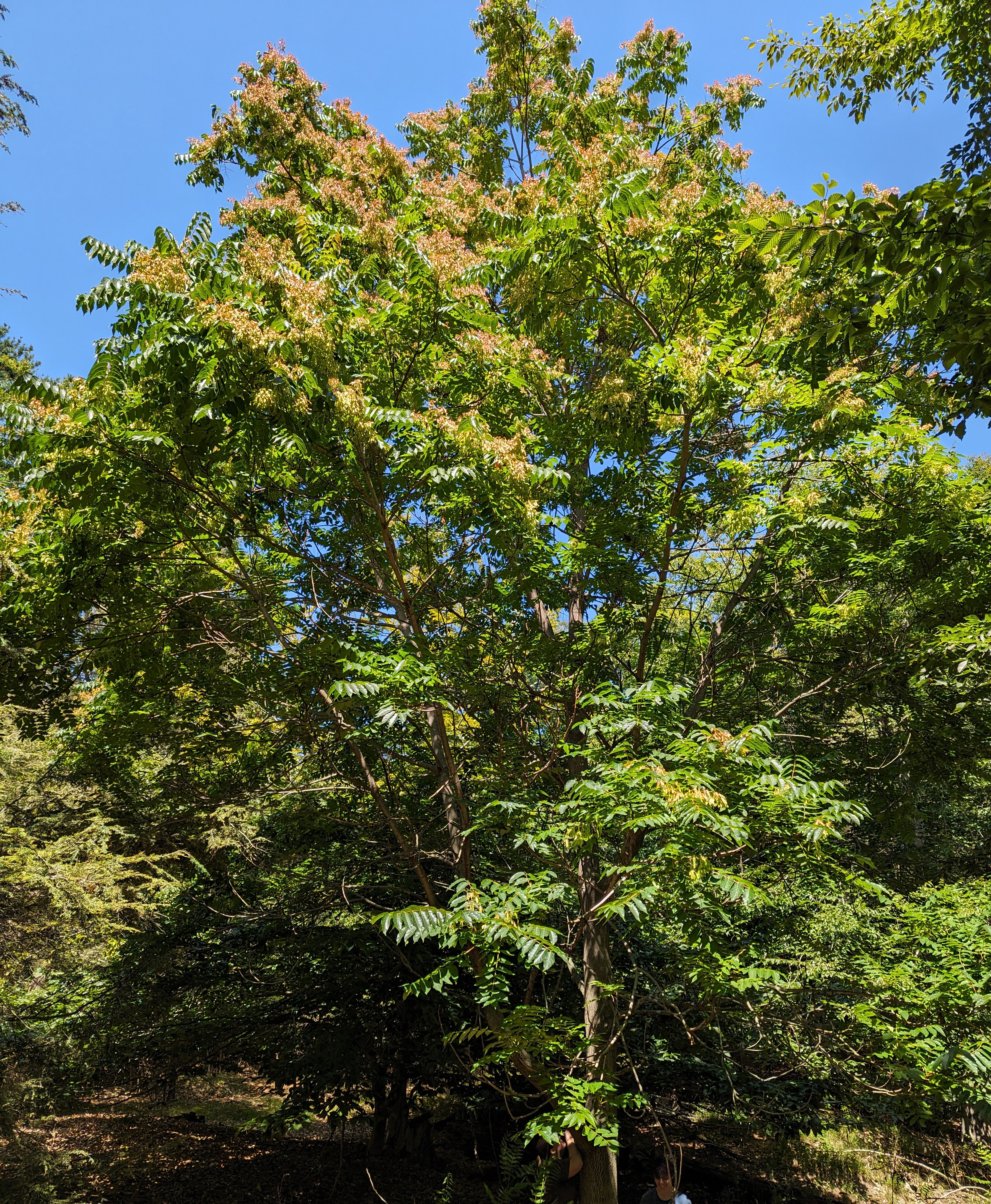
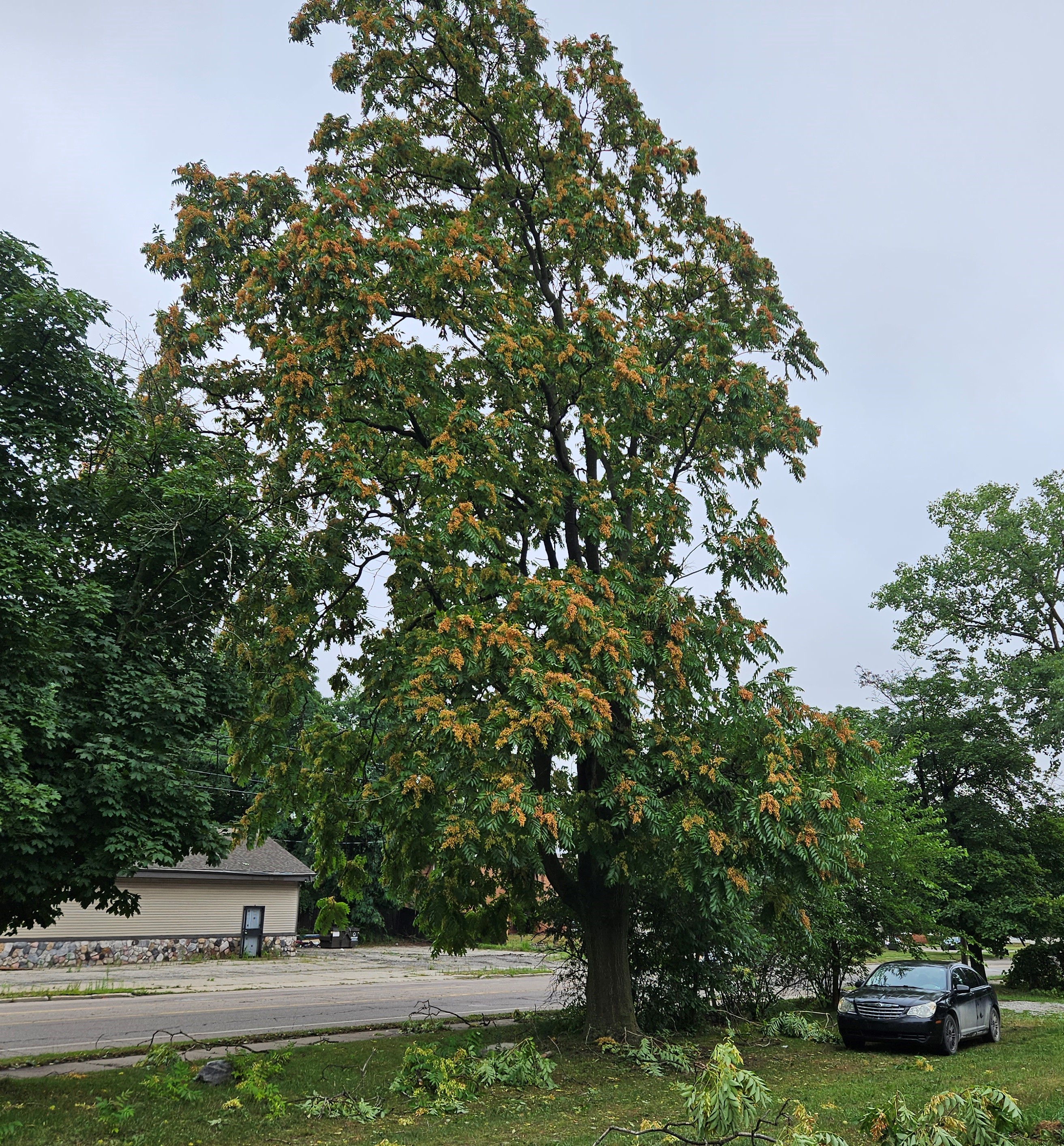
Why are we interested in ToH?
ToH has recently attracted attention because it is the most preferred host of spotted lanternfly (SLF) (Lycorma delicatata White) (Hemiptera: Fulgoridae), an invasive insect pest also native to China. It was first identified in 2014 in southeastern Pennsylvania but is now found in at least 17 eastern states and continues to spread. SLFs use their long needle-like stylets to pierce the bark (Figure 3) and suck sap from the phloem (inner bark) of their host trees. Although SLF can feed on at least 70 species of trees and woody vines, ToH is by far its most highly preferred and suitable host. Immature SLF nymphs and adults have higher survival rates and adult females produce many more eggs when they feed on ToH compared with other tree species.
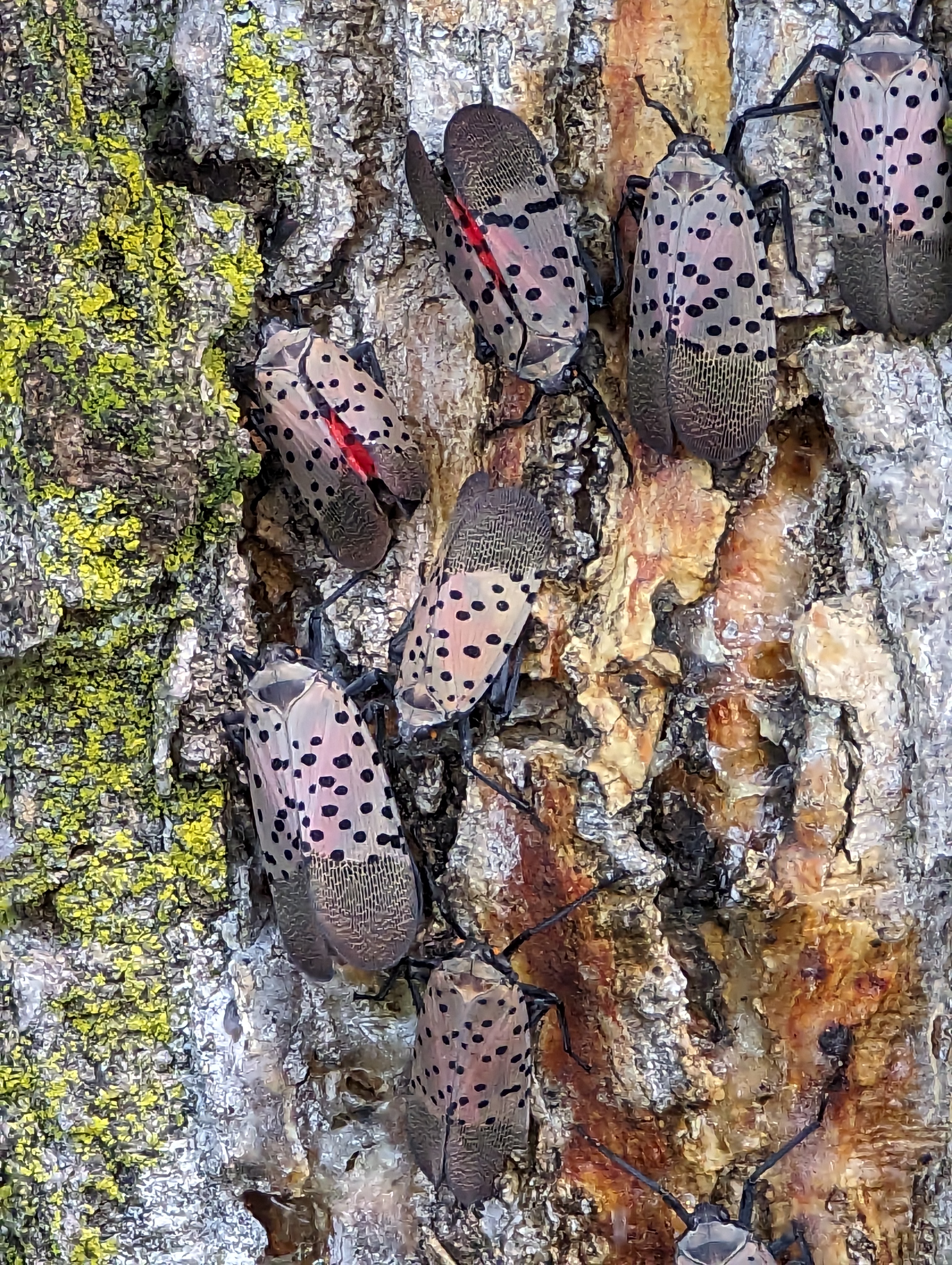
SLF populations can reach high densities in residential and urban areas, as well as in orchards, vineyards, and wooded areas, especially where ToH is present. As the immature nymphs and adults suck sap (Figure 4), they excrete honeydew, which coats the vegetation, sidewalks, driveways, and other objects beneath the infested trees (Figure 5). Sugary honeydew attracts ants and wasps (Figure 6), annoying residents. Black sooty mold that grows on the honeydew is another unwelcome side effect of SLF.
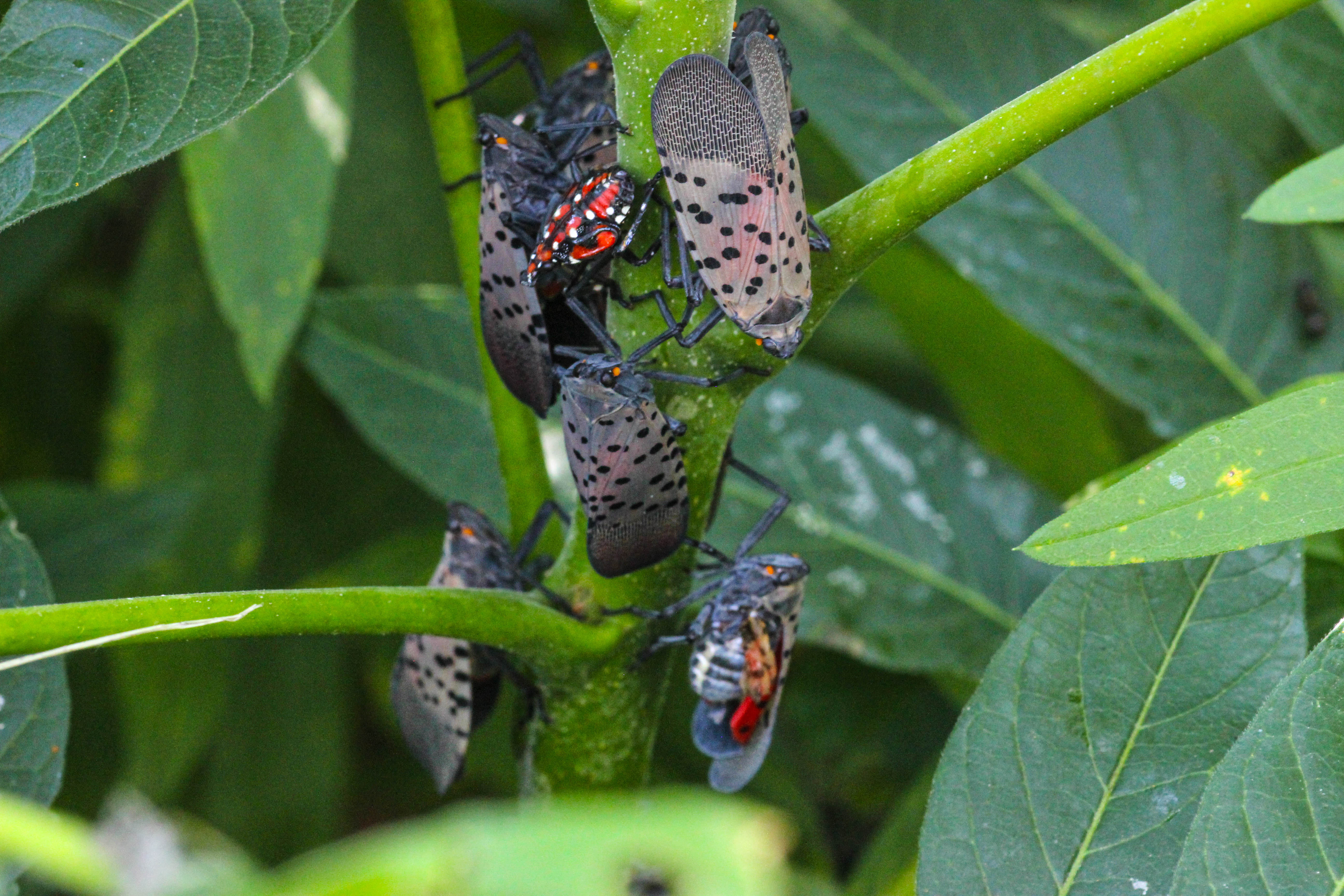
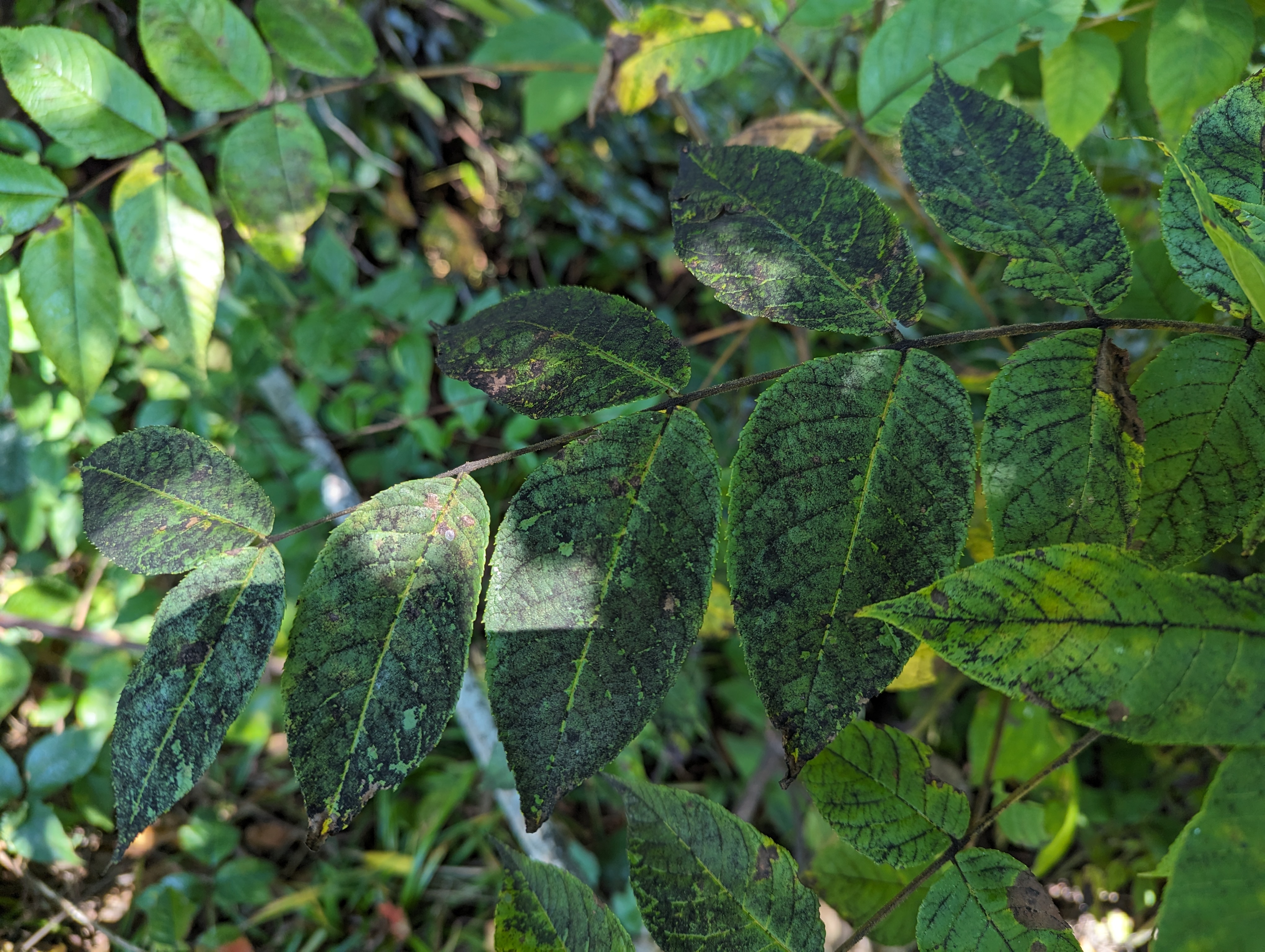
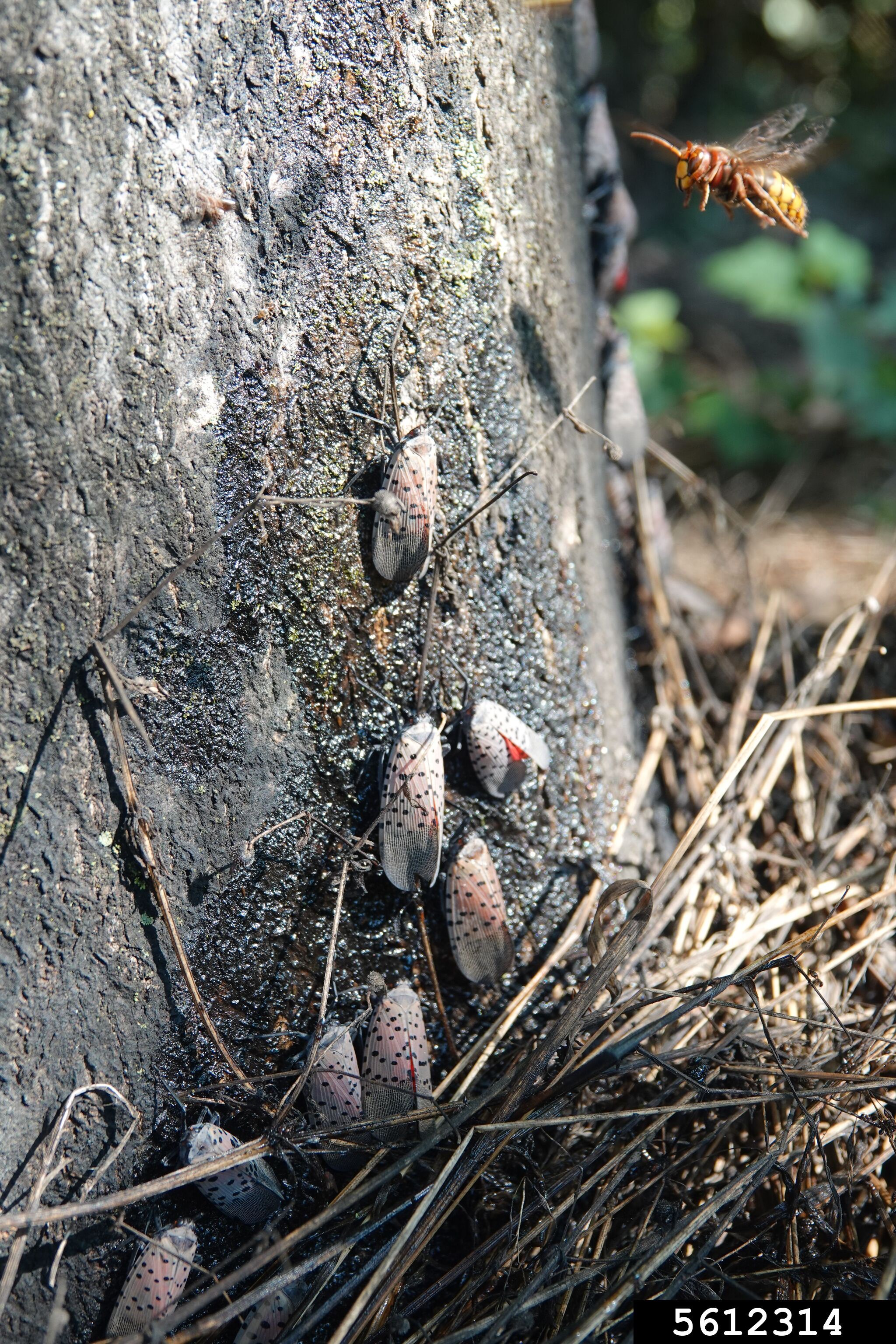
Locating and managing ToH is a key aspect of dealing with SLF and reducing the impacts of this invader in North America. This bulletin is designed to help you identify ToH, which often resembles native trees such as black walnut and sumac. Information about ToH ecology and reproduction, including traits unique to this species, is also included, along with options for removing or controlling this invasive tree.
How did ToH end up in North America?
ToH was a popular shade tree and conversation piece in gardens throughout Europe 300 years ago. It was introduced into the U.S. when young trees from England were planted in Pennsylvania in the late 1700s (Fryer, 2010). Thanks to its rapid growth and ability to survive harsh conditions, ToH was widely planted in parks and along streets in the U.S. and around the world. It is now established on every continent except Antarctica. ToH was eventually introduced to California and other western states by Chinese immigrants, who valued the tree as a source of homeopathic remedies for an array of health concerns (Fryer, 2010).
Eventually, however, the popularity of ToH waned because of the foul-smelling flowers, prolific seed production, damage to streets, and compromised sewers caused by fast-growing roots. In the U.S., ToH still is common in the northeastern and western states near those early introductions, but it has also spread throughout much of the Midwest, Great Plains, and southeastern regions (Figure 7). Thirty states, including Michigan, currently list ToH as an invasive species.
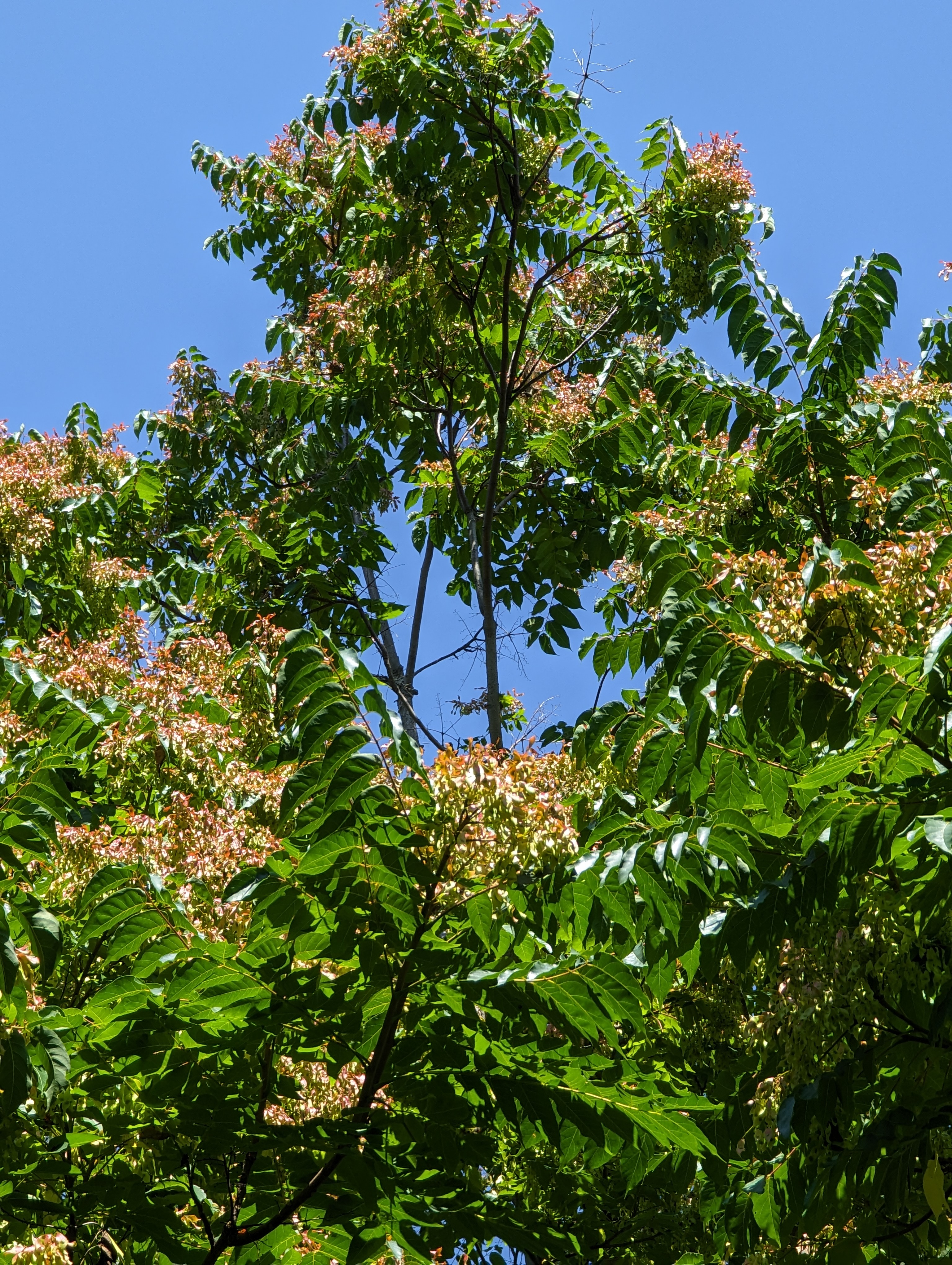
Where does ToH grow?
ToH can grow on a wide range of soil types. It tolerates drought and pollution, but does not do well on sites that are often flooded. It is especially common in disturbed areas, including alleys or railroad yards, along train tracks, highways, local roads. and sidewalks, and even on abandoned mining sites. ToH is generally intolerant of shade, although established trees can tolerate partial shade (figures 8–11). In wooded areas, ToH is typically found along edges where light is abundant. This species is one of the fastest growing trees in North America. Both the common name (tree of heaven) and the Latin genus (Ailanthus means “sky-tree”) refer to the tree’s ability to grow vertically. Height of young trees may increase by 3 feet per year. Mature trees generally are 60 to 80 feet tall and can be 4 to 6 feet in diameter.
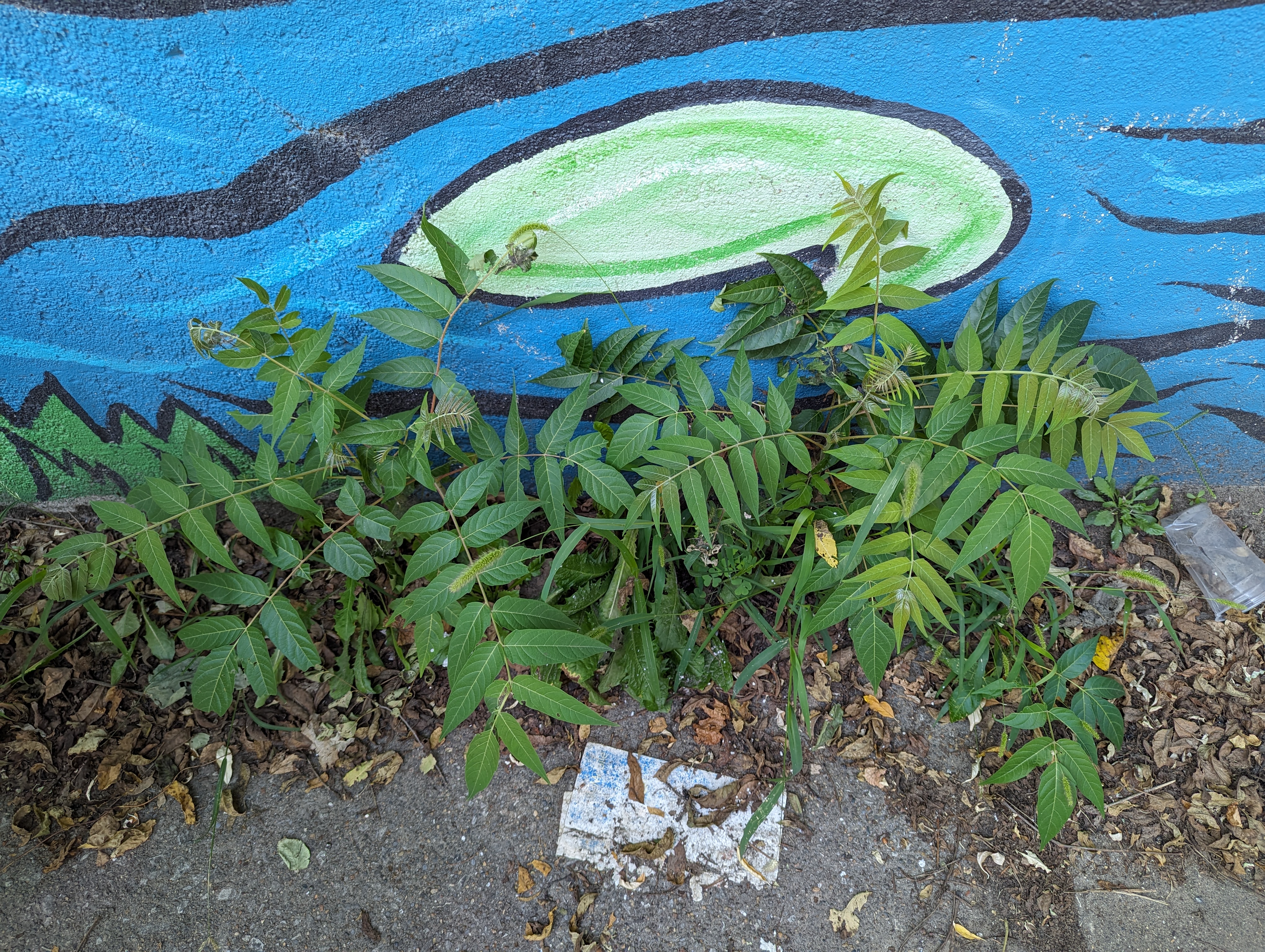
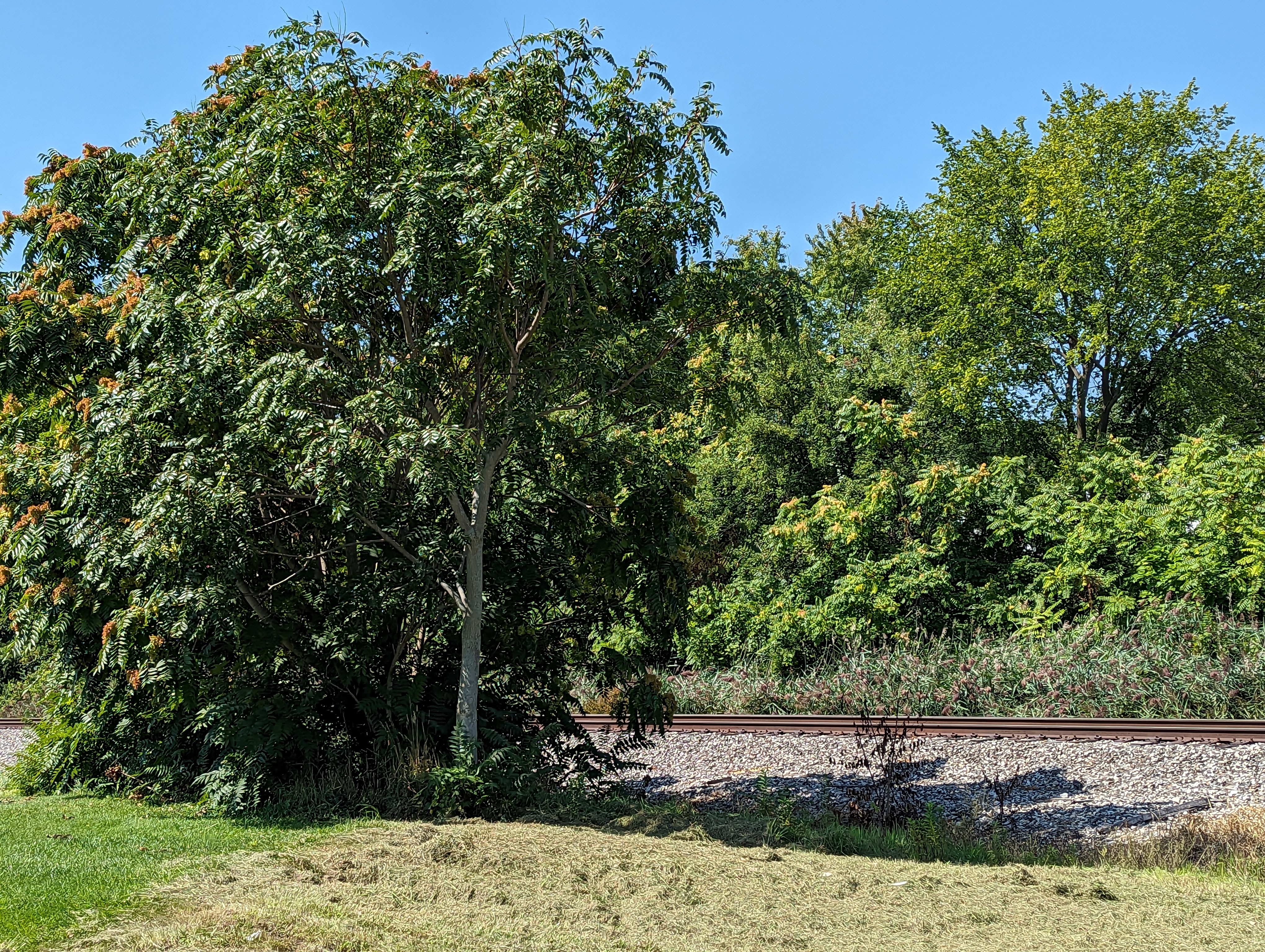
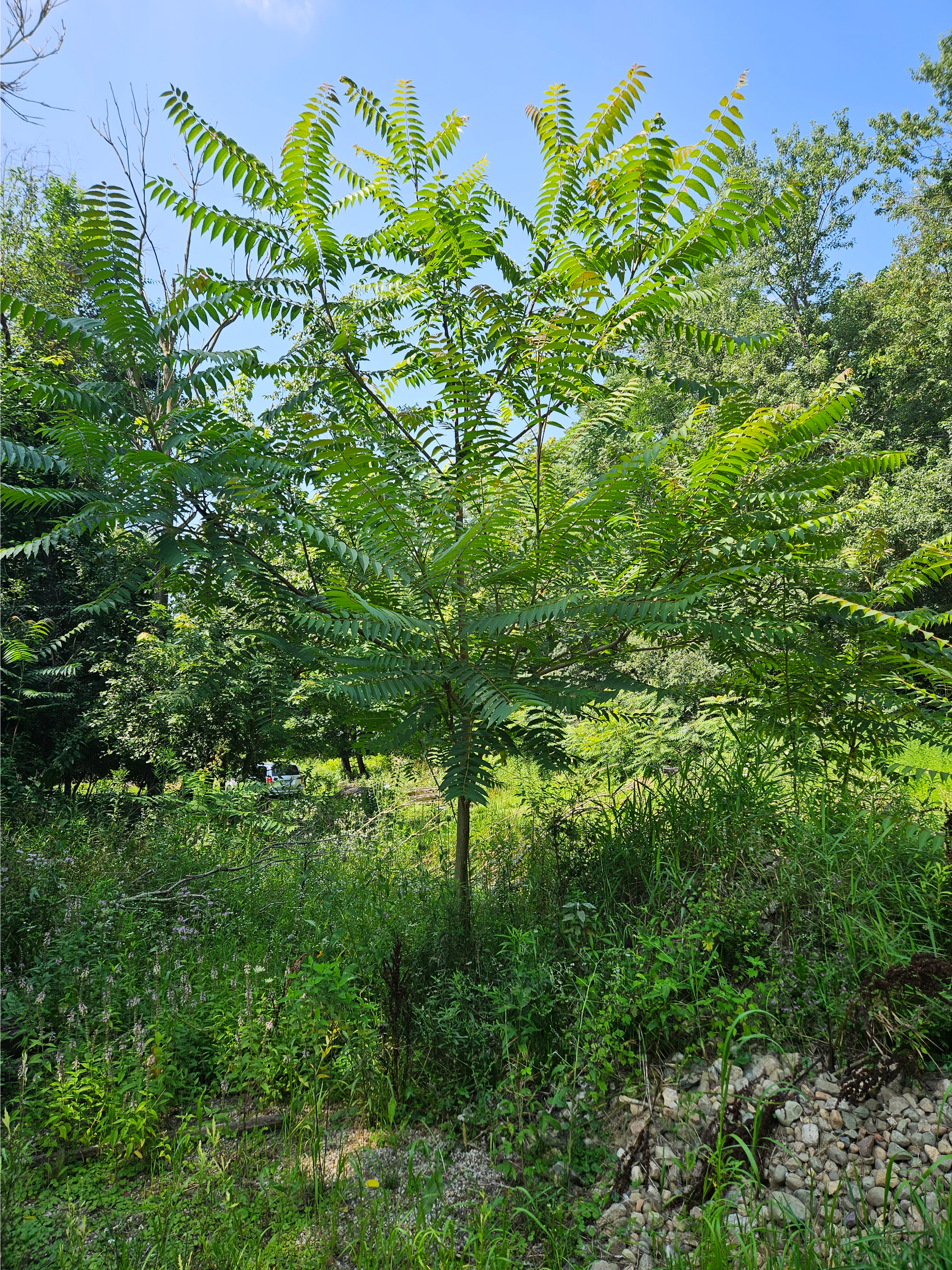
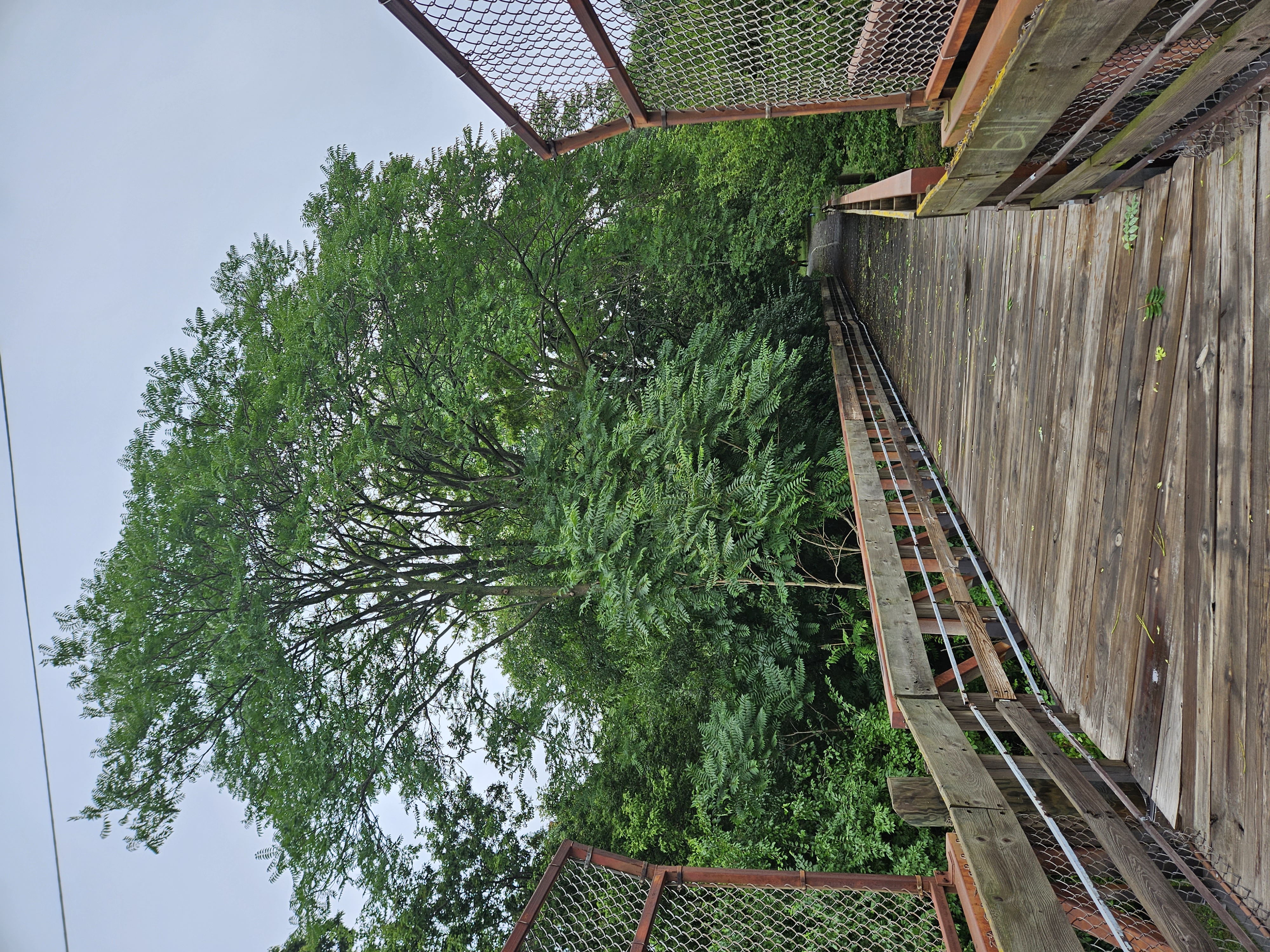
Will wildlife feed on ToH? What about pollinators?
Leaves and bark of ToH contain bitter compounds. Deer, livestock, and small rodents generally feed on ToH only when alternate choices are limited. Because of this, ToH establishment and growth are rarely limited by browse damage. Since goats will eat ToH foliage and bark, they may be helpful in controlling young trees. Most animals avoid eating ToH seeds, despite their high protein and fat content. A few species of birds, including pine grosbeak and crossbills (a type of finch), will eat the seeds.
ToH is a favorite resource for pollinators thanks to the strong scent of the flowers (Figure 12), which most people find unpleasant. Flowers also attract ants, however, which may limit visits by other insects. Honey made from ToH pollen initially has an unpleasant flavor that mellows with age.
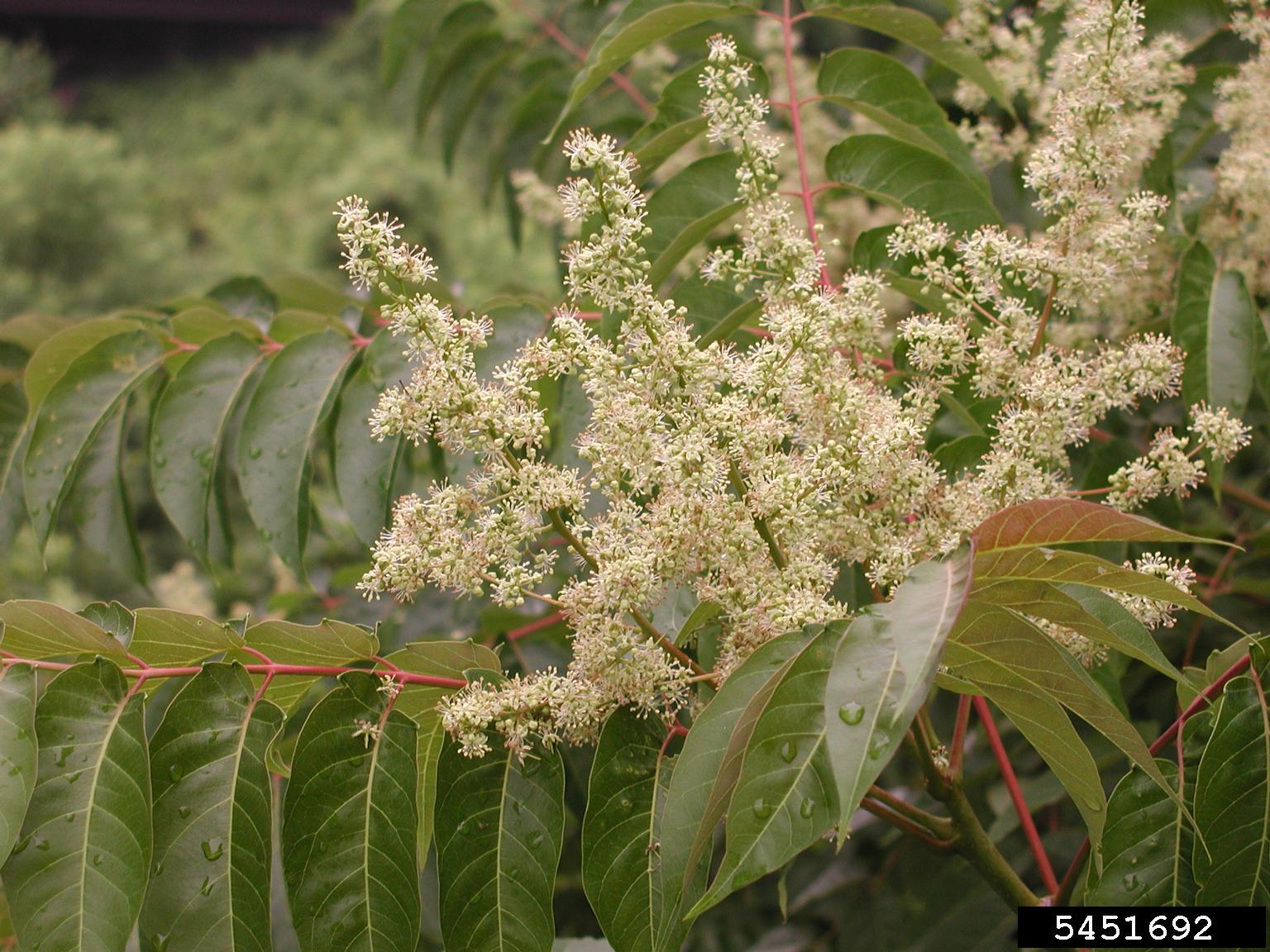
Are there any good uses for ToH?
Historically, in its native China and other Asian countries, ToH was valued as a shade tree. It provided fiber, food, and firewood, and was used for traditional medicinal purposes. Different portions of the tree were used for different applications. For example, extracts from some tissues reportedly have antibacterial, antioxidant, or anti-inflammatory properties. Firewood can yield heating values similar to those of white ash, white oak, and American beech.
Why has ToH been considered a noxious and invasive plant species for so long?
ToH fell out of favor in the U.S. decades ago, thanks to its aggressive growth and negative effects on more desirable plants and even people. The recent invasion by SLF, however, has heightened efforts to locate and control ToH.
Allelopathic compounds produced by ToH affect many plants, including tree species, by either preventing their establishment or slowing their growth. Young ToH trees typically have high concentrations of allelopathic chemicals, which likely helps clumps or clones of trees establish and spread. In mature trees, allelopathic toxins are highest in spring, then decline throughout the growing season. Allelopathic chemicals are especially high in ToH roots but are present in all parts of the tree, including leaves that have dropped in autumn.
Like the aboveground portion of the tree, roots of ToH grow rapidly and can exploit cracks in the structure of building foundations and roads (Figure 13). Water-seeking roots can plug up sewer lines and invade wells, causing damage and giving drinking water an unpleasant taste.
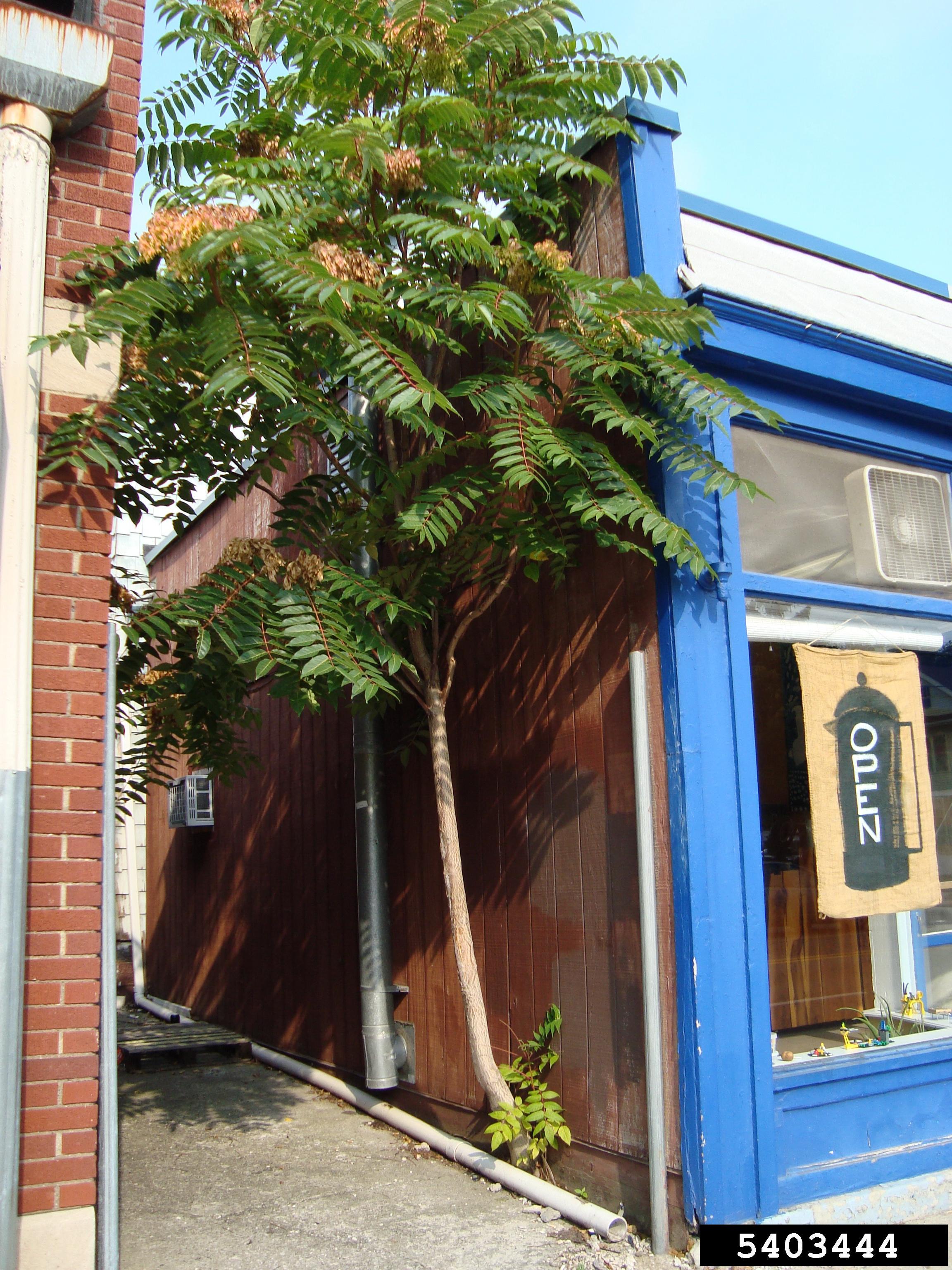
ToH can even pose health risks for people. Male trees produce abundant pollen in spring, affecting people with seasonal allergies, while contact with ToH foliage, seeds, or bark can cause skin irritations for sensitive individuals. In rare cases, myocarditis (heart inflammation) has been linked to consumption of ToH sap or exposure to sap through open cuts or blisters.
Why is ToH so invasive?
ToH has an amazing ability to reproduce and regenerate. It is a dioecious species, meaning that individual trees are either female or male. Female trees are prolific seed producers. Even a one-year-old tree can produce seeds, while a mature tree can produce more than 350,000 seeds per year (figures 14-a and 14-b). These lightweight seeds, each within a twisted samara, can be carried long distances by wind or in water. Germination rates are higher than those of most other trees. These traits enable new colonies of ToH to become established even in areas where mature trees are not present.
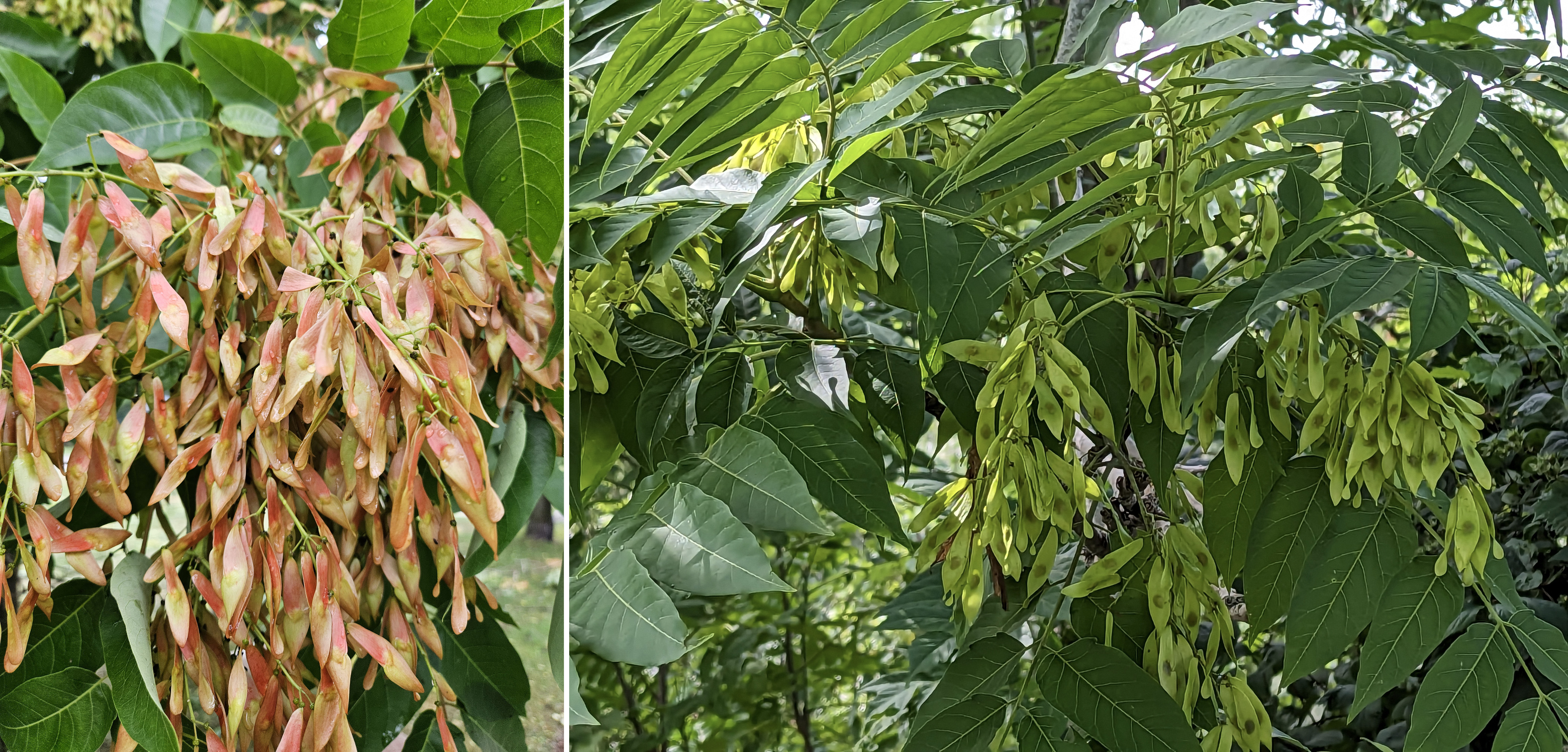
ToH is also exceptionally good at vegetative regeneration. Root sprouts and stump sprouts can be abundant and can grow vigorously by tapping into resources stored in the roots. Sprouts may grow 3 feet in height in a single season (Figure 15). Root systems of mature ToH can extend as much as 90 feet from the parent tree and new sprouts can originate at nodes anywhere along the roots. These regeneration and reproductive strategies allow ToH to quickly establish and spread, sometimes leading to dense clumps or clones comprised exclusively of ToH.
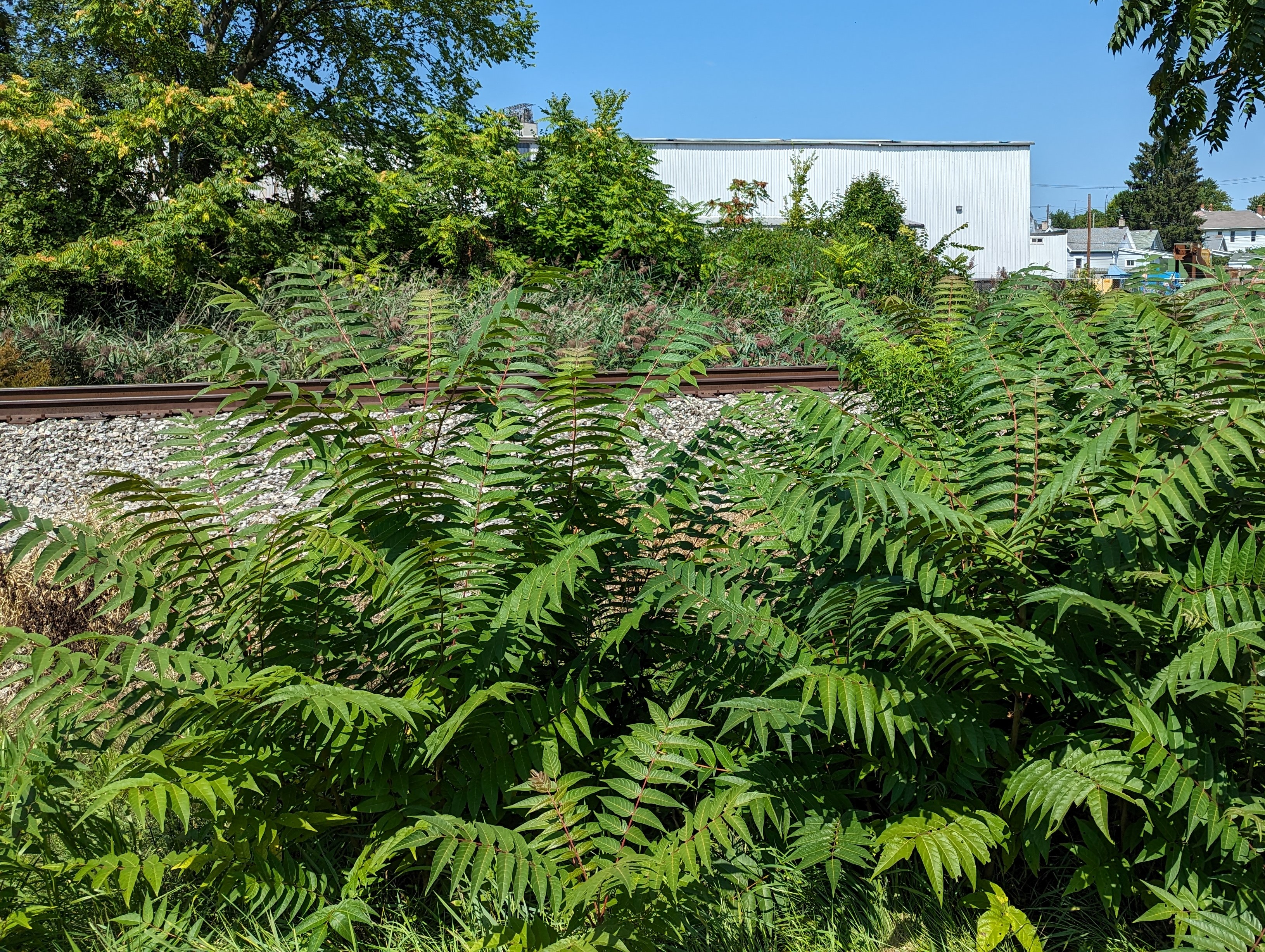
What traits can I use to identify ToH?
It can be easy to confuse ToH with native species, especially sumac (Rhus spp.) and walnut (Juglans spp.). From a distance, ToH and black walnut trees can look very much alike, especially if you are viewing the canopy or the foliage. Sumac, which often grows in a dense clump, is usually a shrub or small tree, but sumac leaves are certainly similar to those of ToH. Look carefully at the bark of the trees. Bark, along with the tree leaves, flowers, and seeds, will help you identify ToH and distinguish this invader from desirable native trees.
Bark
Young ToH trees have smooth, thin bark (Figure 16-a) that is light brown to greenish-gray, with numerous small, lighter spots. Large, heart- or V-shaped leaf scars are often present along the stem. These leaf scars will flatten and fade as the tree grows. As trees grow and mature, the bark becomes darker gray with an interwoven or diamond pattern (Figure 16-b). Bark on mature ToH trees (Figure 16-c) appears similar to the skin of an elephant or the outer rind of a cantaloupe melon.
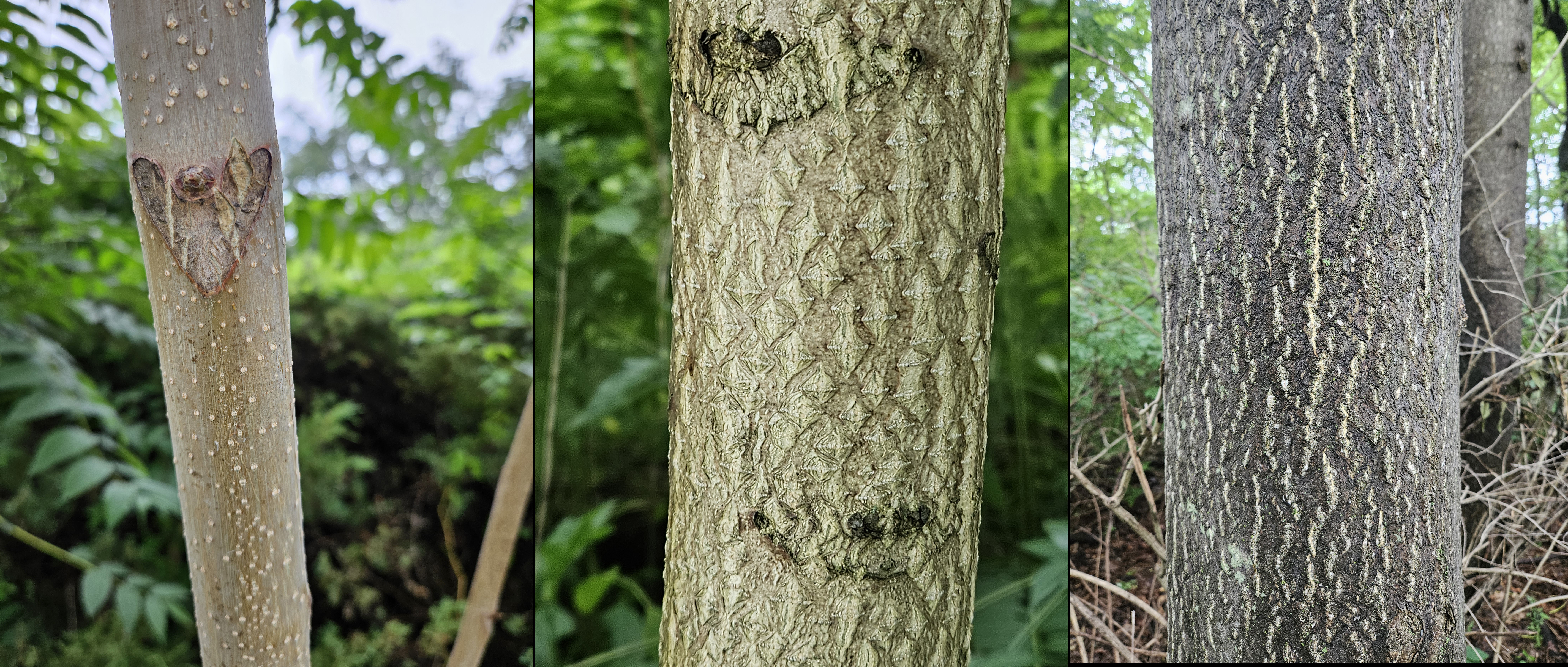
Leaves
ToH has compound leaves composed of numerous leaflets (Figure 17) on a long petiole. Leaf size and the number of leaflets is highly variable. Most leaves are 1 to 4 feet long, with an odd number of leaflets. Leaves usually have 11 to 25 leaflets but occasionally a leaf may have up to 41 leaflets. Leaflets have smooth edges or margins. There are 1 to 4 small lobes (Figure 18) near the base of each leaflet called glandular teeth. Crushing ToH leaves produces a strong, distinct, and unpleasant odor.
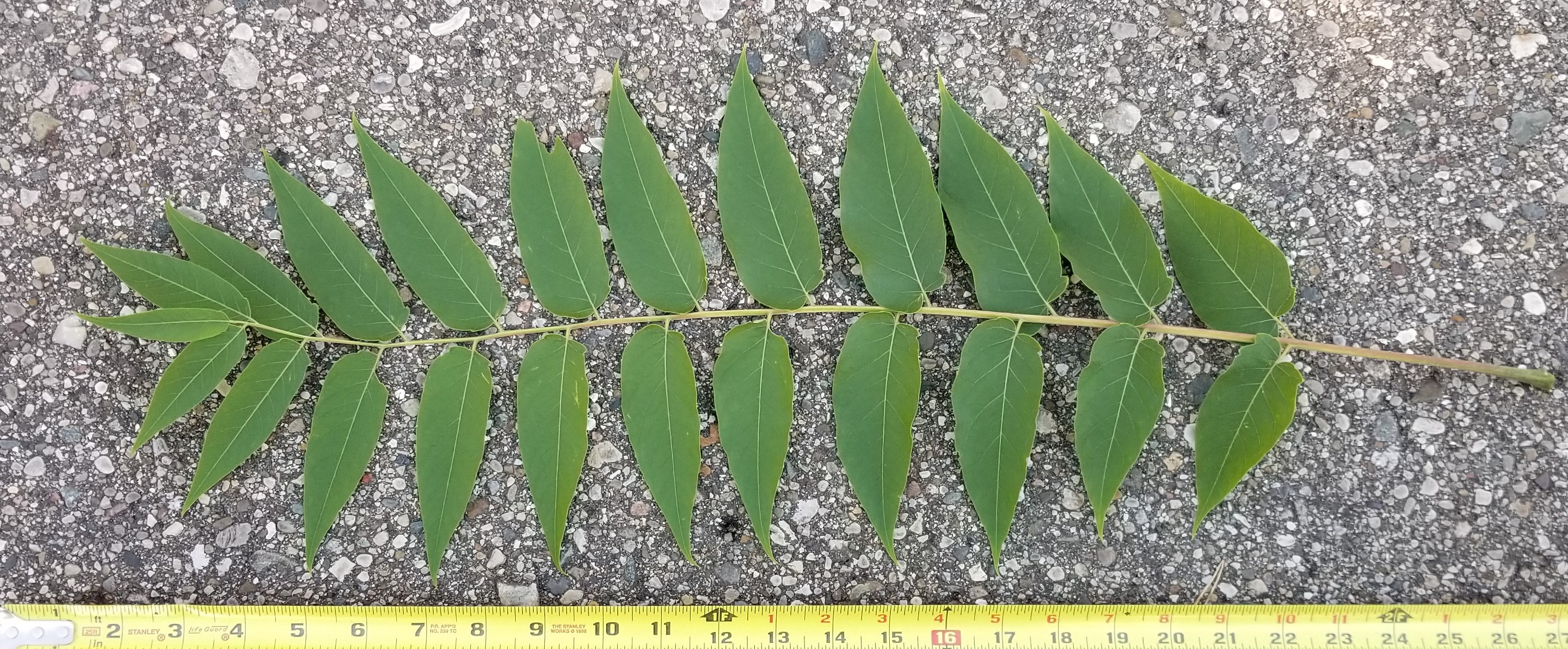
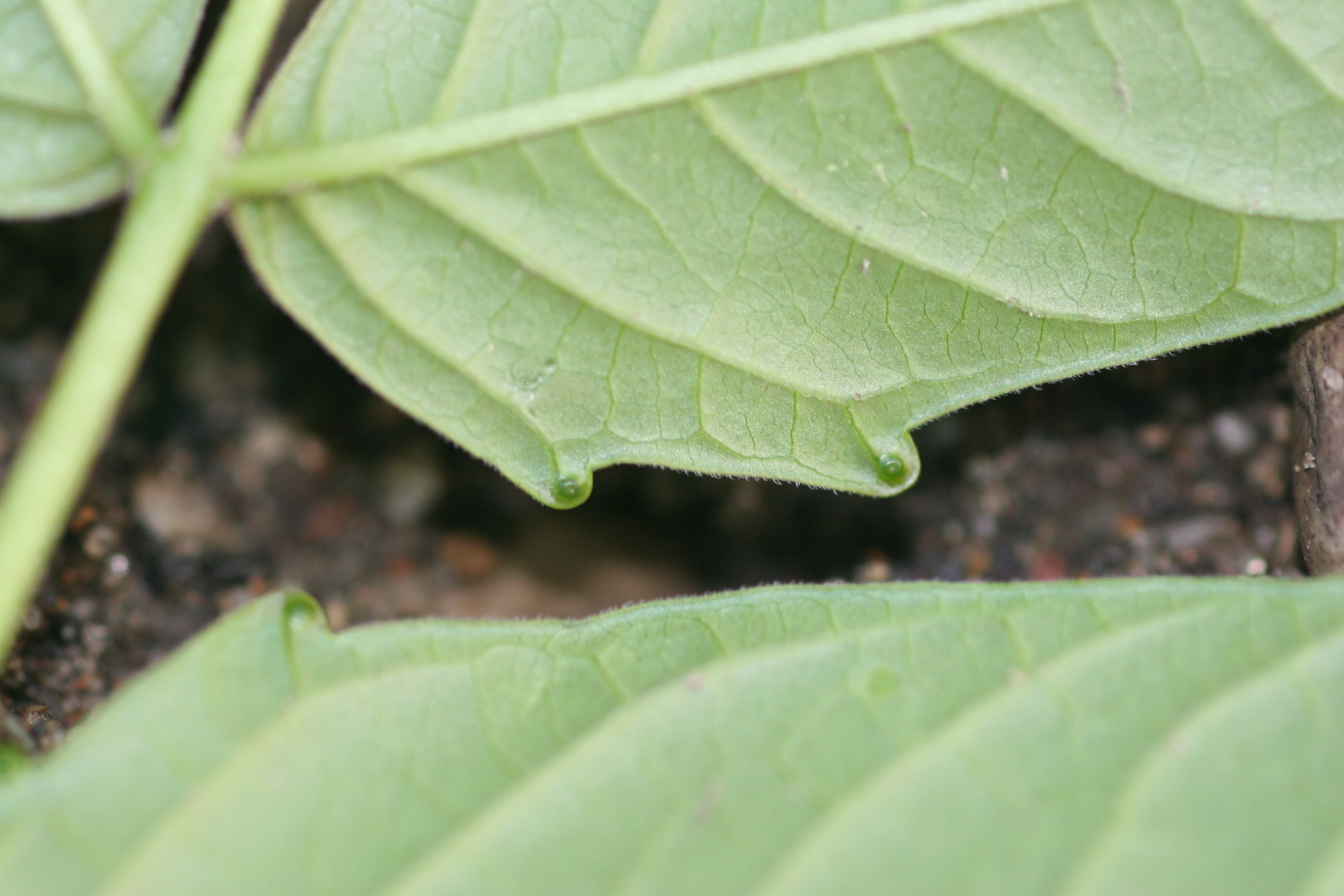
Flowers
Flowers (Figure 19) are produced by both male and female trees, beginning in April and continuing into July. Flowers are small, yellowish green, and occur in clusters above the foliage at the ends of branches. On male trees, flower cluster are more abundant, larger, and more foul-smelling than flowers on female trees.
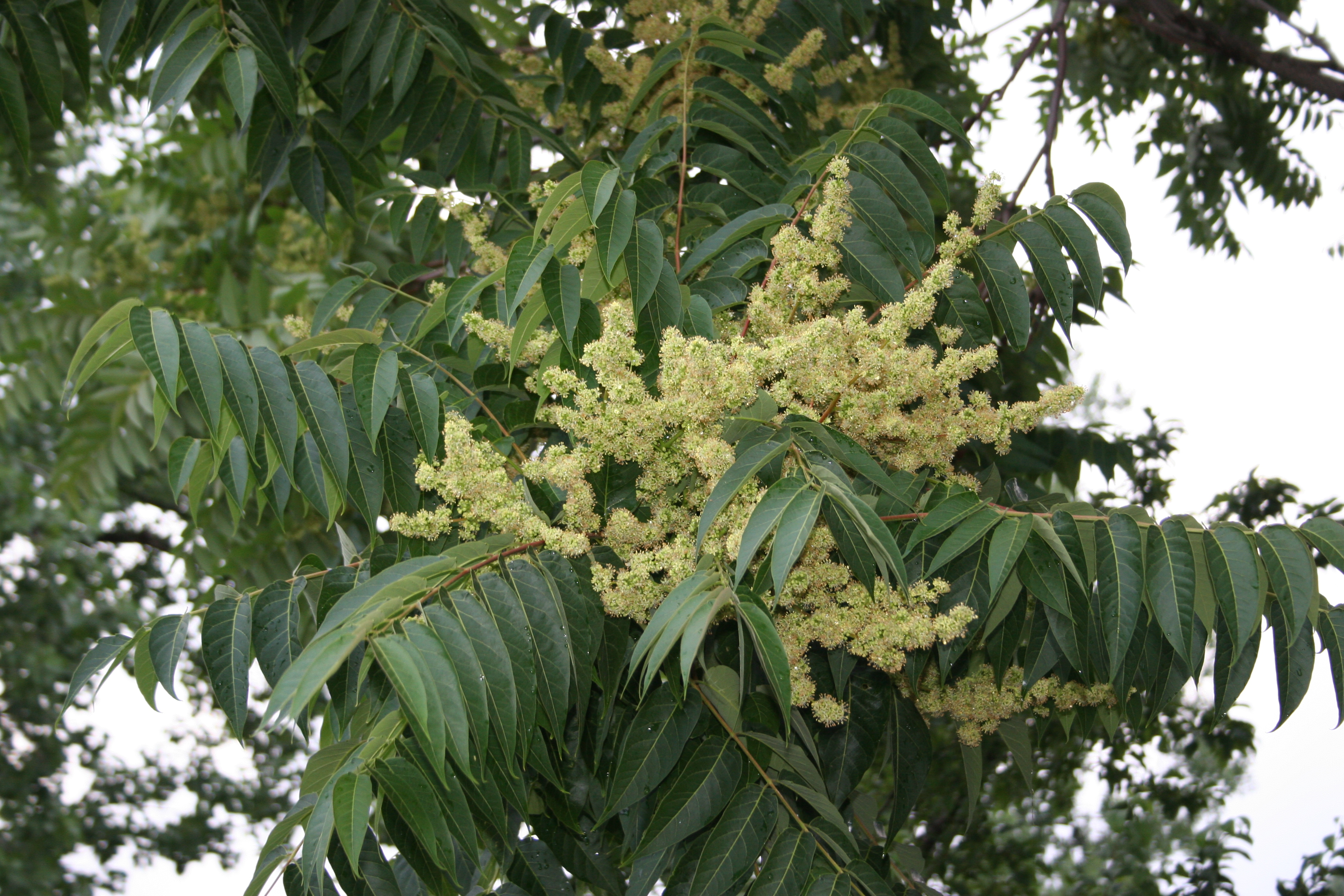
Seeds
Seeds (Figure 20) occur in large clusters that may contain hundreds of seeds. Each seed is 1 to 2 inches long within a twisted, winged samara that is greenish yellow to reddish pink. Seeds of ToH are often retained on trees through the winter. Seeds will turn light brown or tan as they dry out.
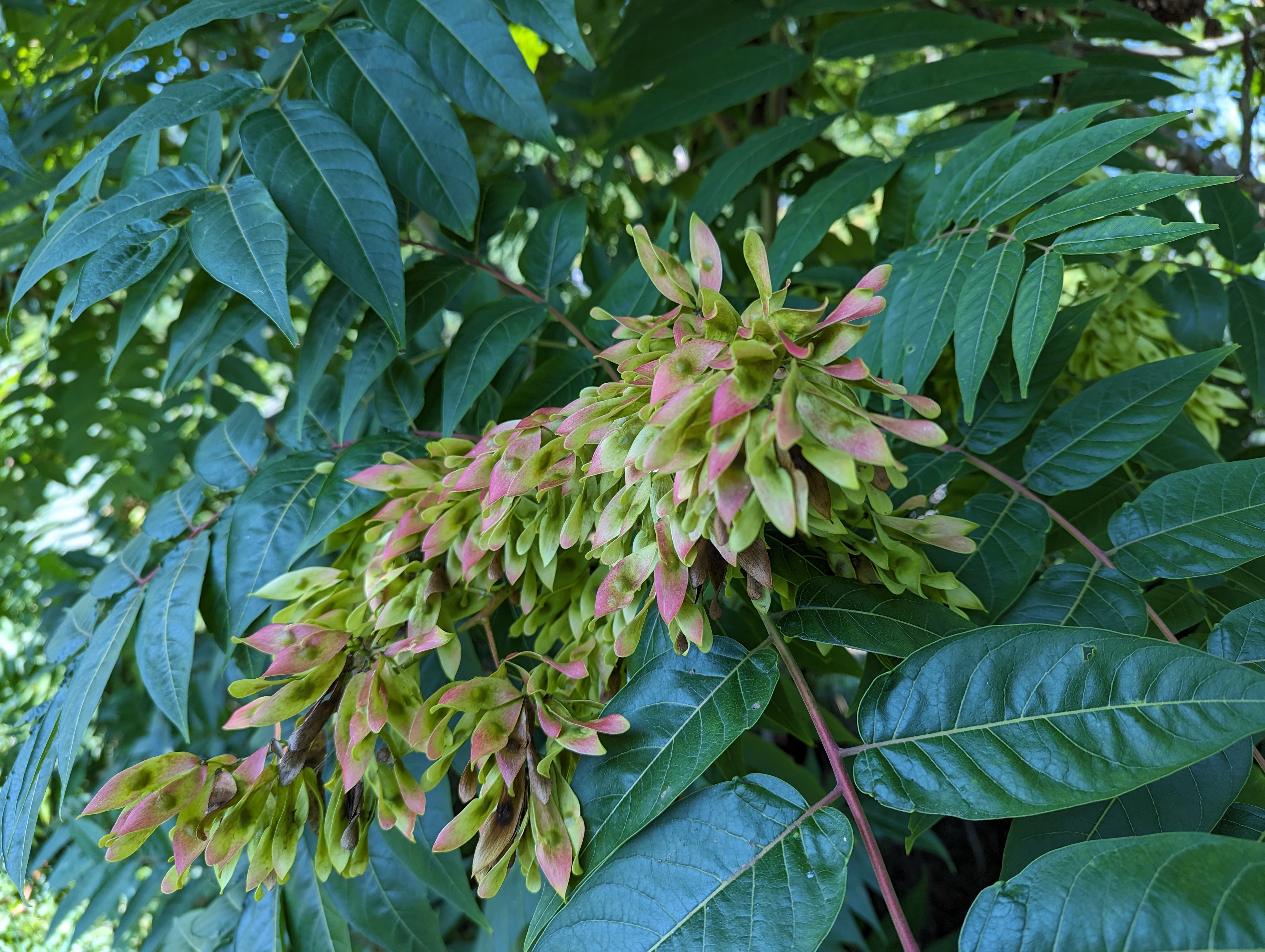
What other species are likely to be confused with ToH?
Black walnut
Native to Michigan, black walnut (Juglans nigra) (Figure 21) is common across much of the state. English walnut (Juglans regia) is not nearly as common but is occasionally planted in landscapes or in forested areas for nut production. Walnut can be easily confused with ToH, especially when trees are young. Both species have compound leaves, but walnut leaflets have toothed, serrated margins and fewer leaflets than ToH leaves (Figure 22). When walnut leaves are crushed, they have a pleasant, nutty scent, while crushed ToH leaves have a foul scent. The bark and fruit also differ substantially. Walnut bark (figures 23 and 24) is deeply textured, gray-brown or dark brown on older trees, and furrows in the bark form an interlaced pattern. Walnuts produce large, fleshy green fruits with a kernel (the actual walnut) inside a hard-shelled hull (Figure 25). Walnut fruit or fruit remnants can often be found around the base of trees year-round.
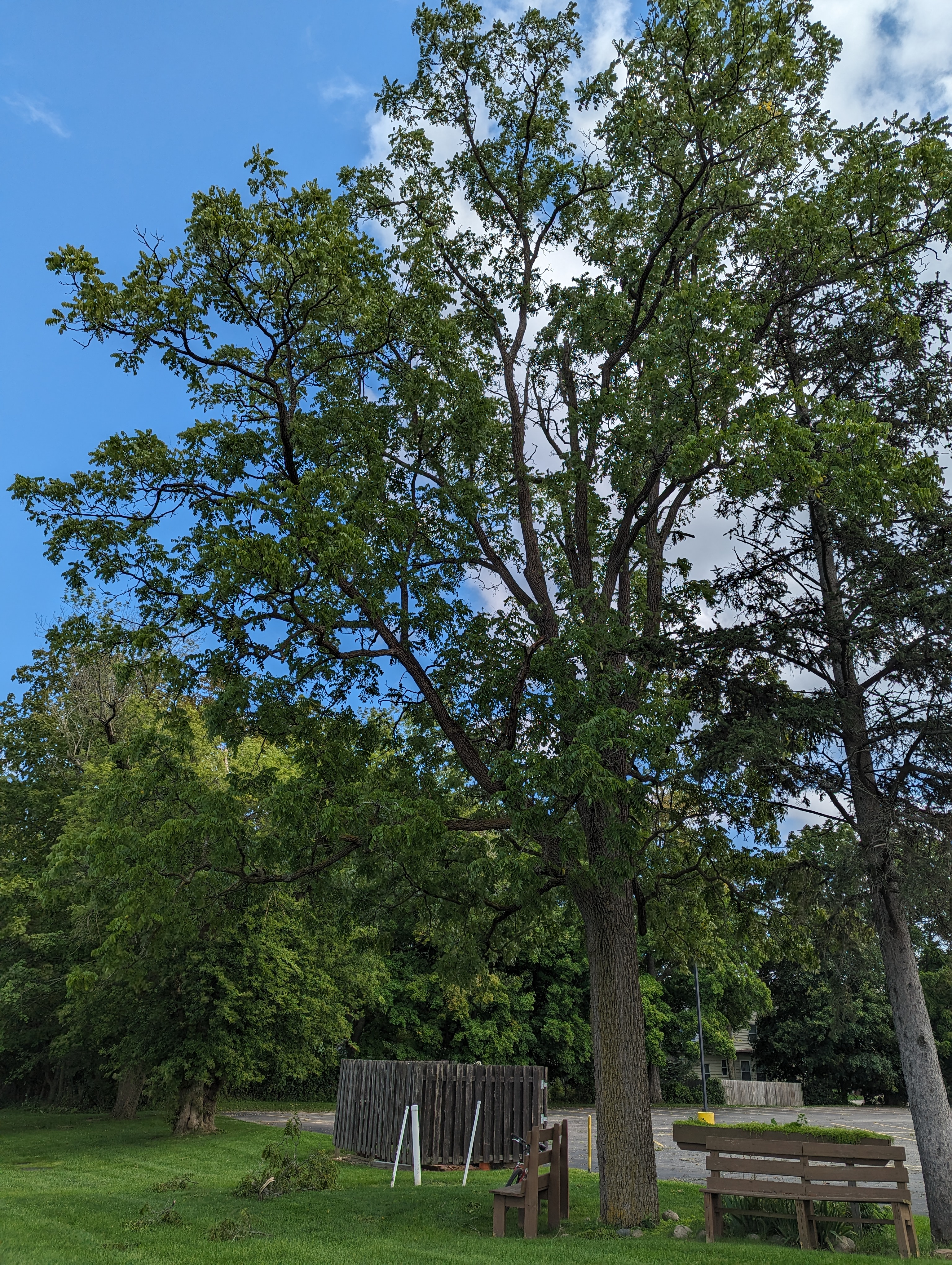
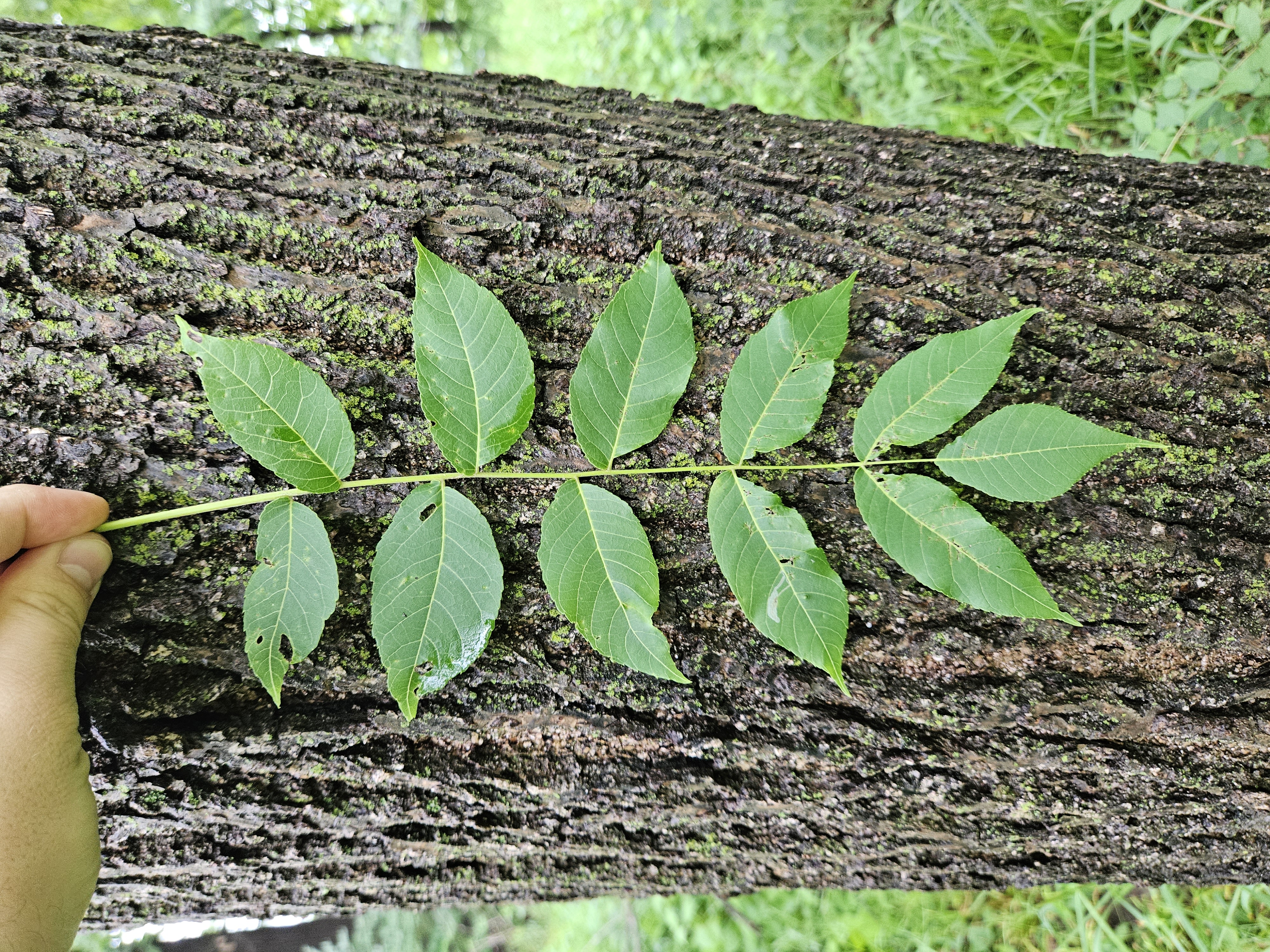
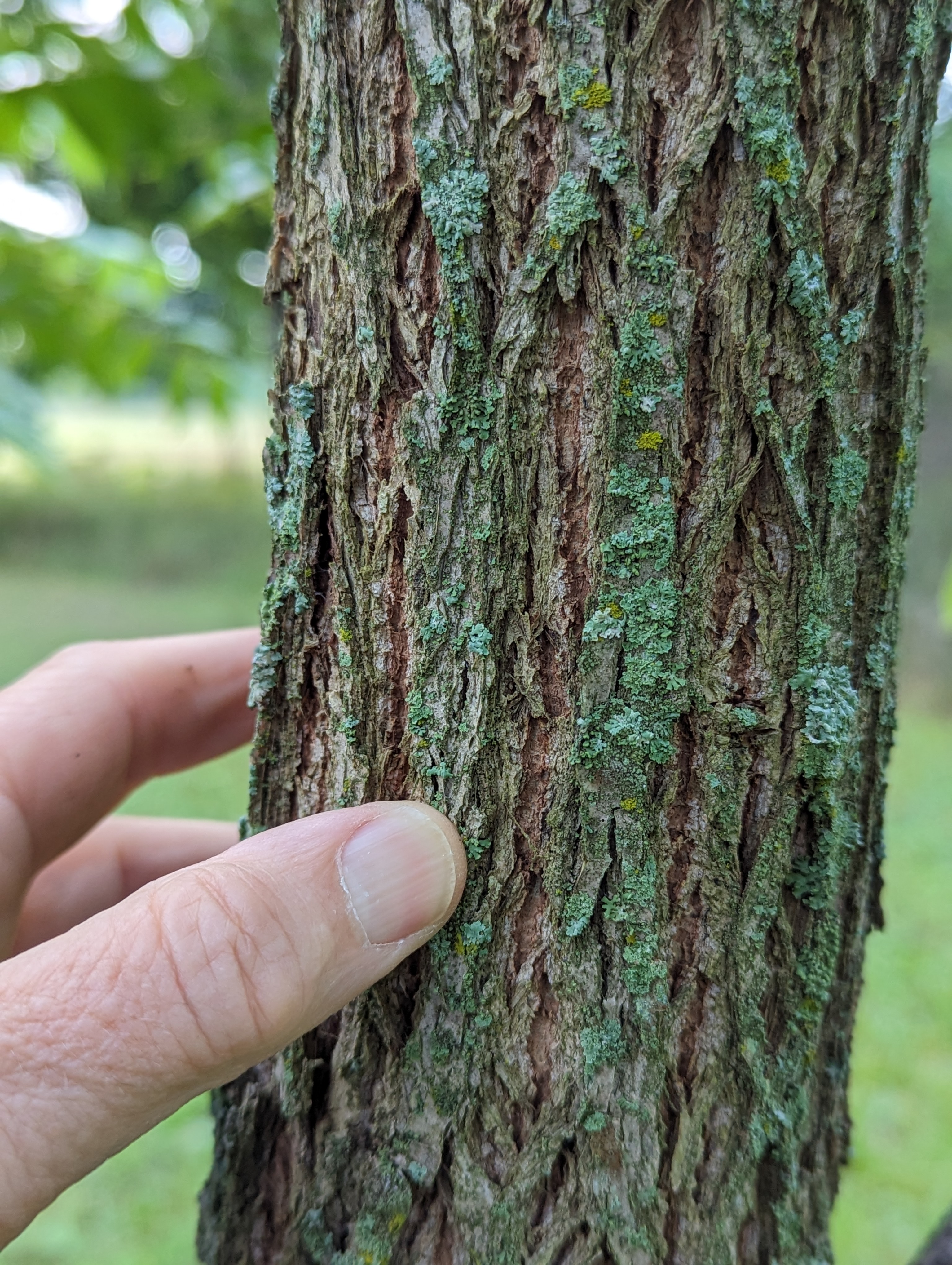
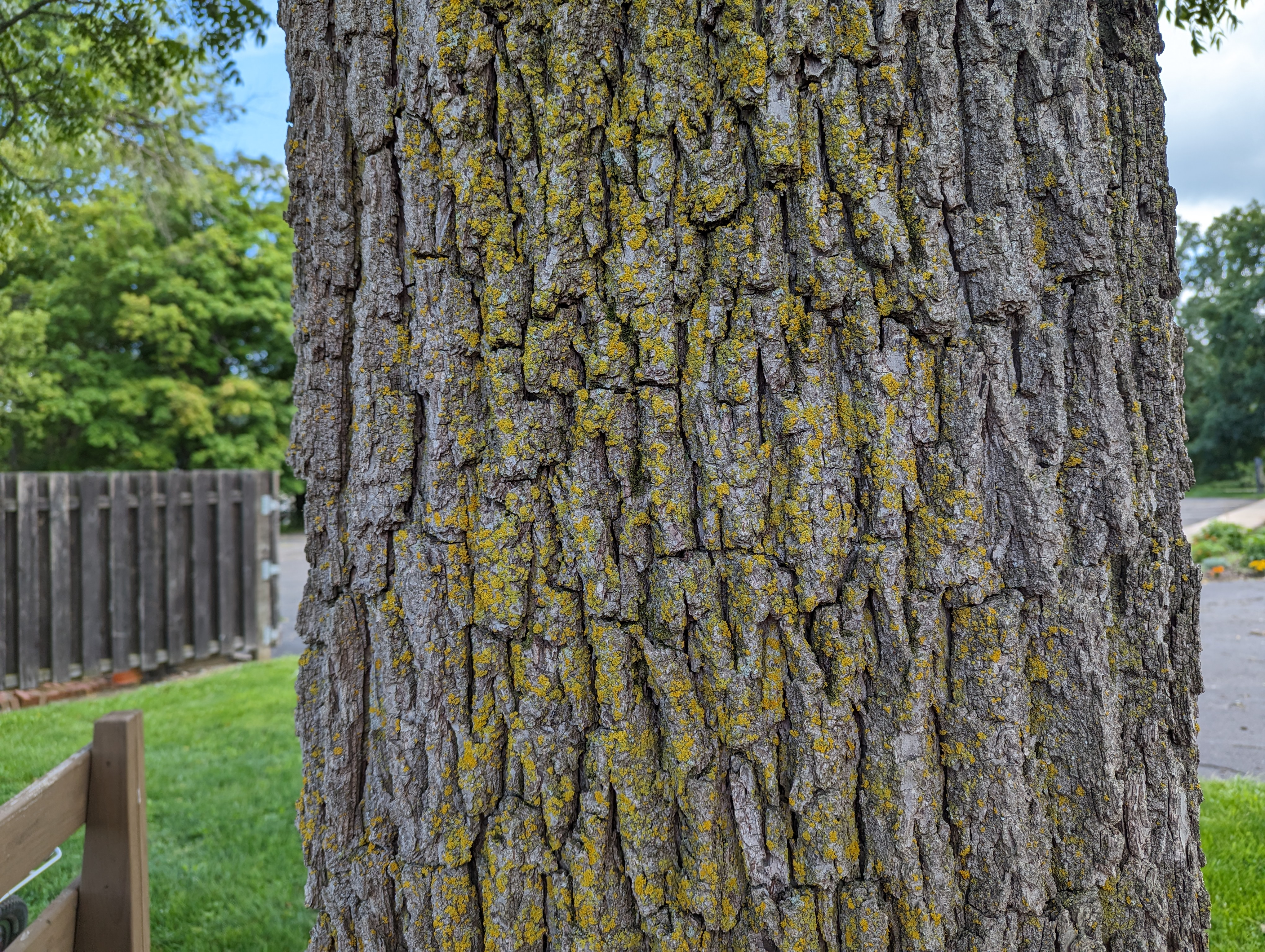
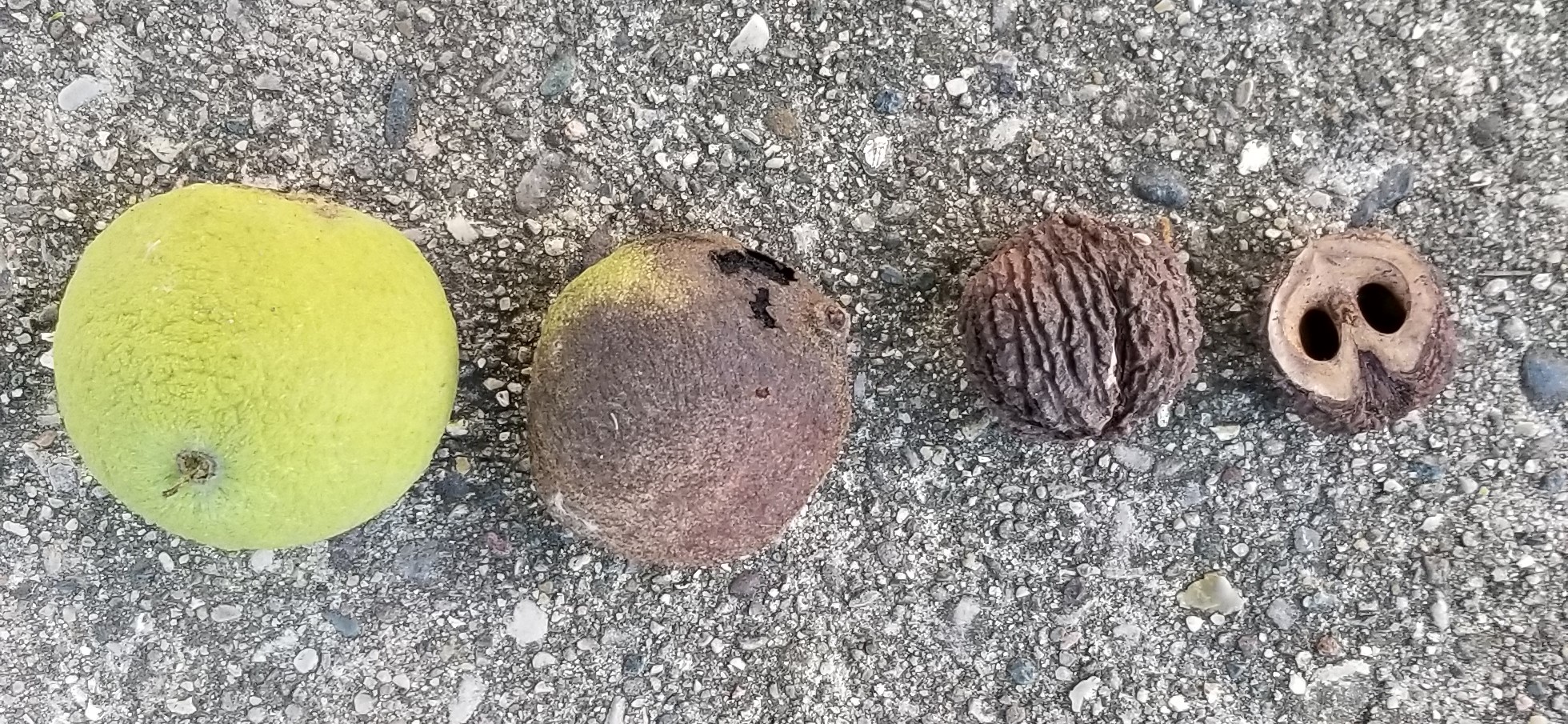
Sumac
Sumac (Rhus spp.) is often confused with ToH, both because of their similar appearance and because sumac can grow in disturbed areas similar to those where ToH is likely to be found. Often shrubby, sumac frequently grows in dense clumps (Figure 26) that tend to spread outward rather than growing upward. While ToH trees can be 80 feet tall, sumac stems rarely exceed 20 feet in height. Sumac is most easily identified by the clusters of reddish-brown, hairy fruit that extend from upper and outer shoots (Figure 27). These fruits appear in mid-summer and persist through the winter.
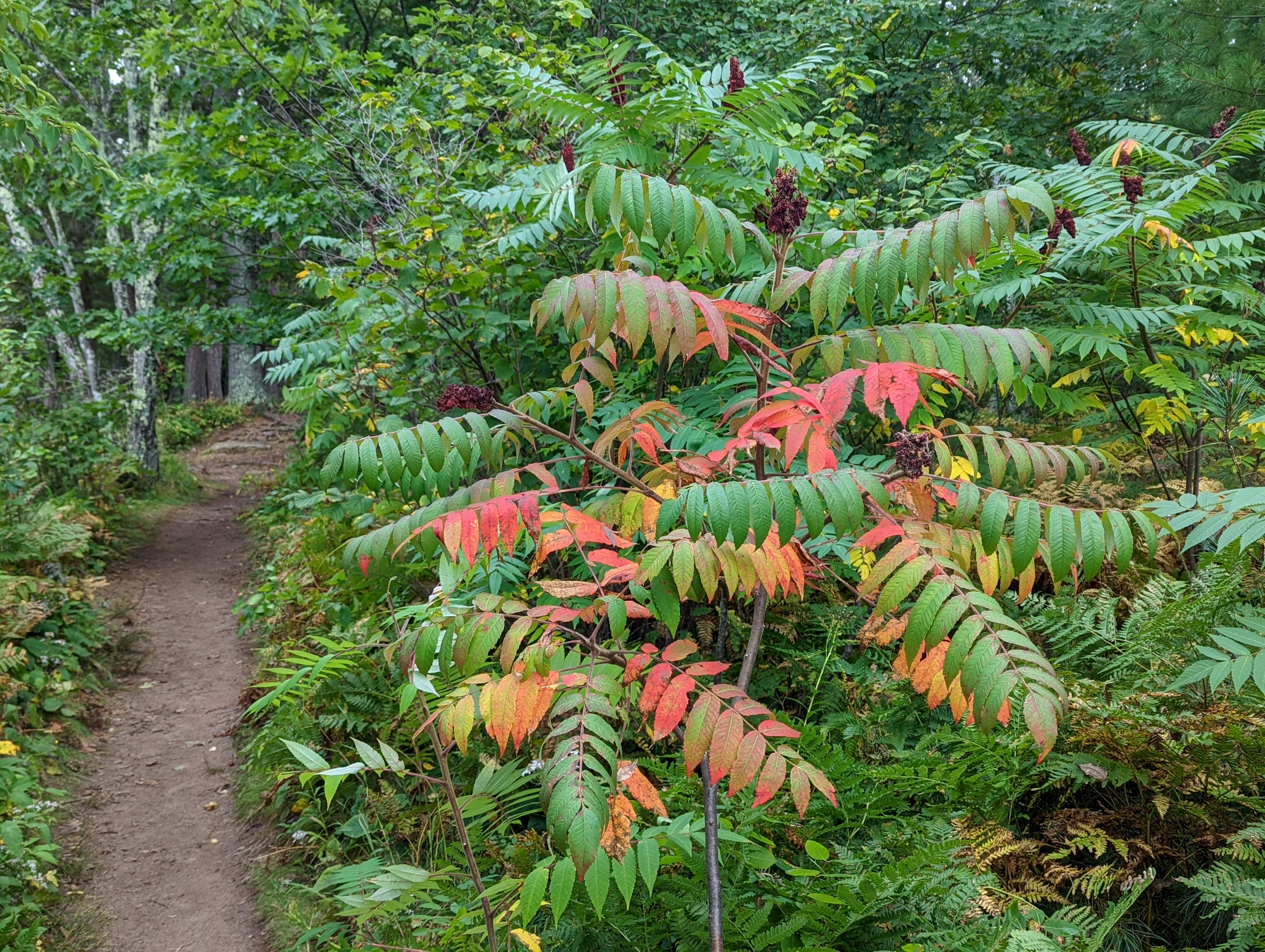
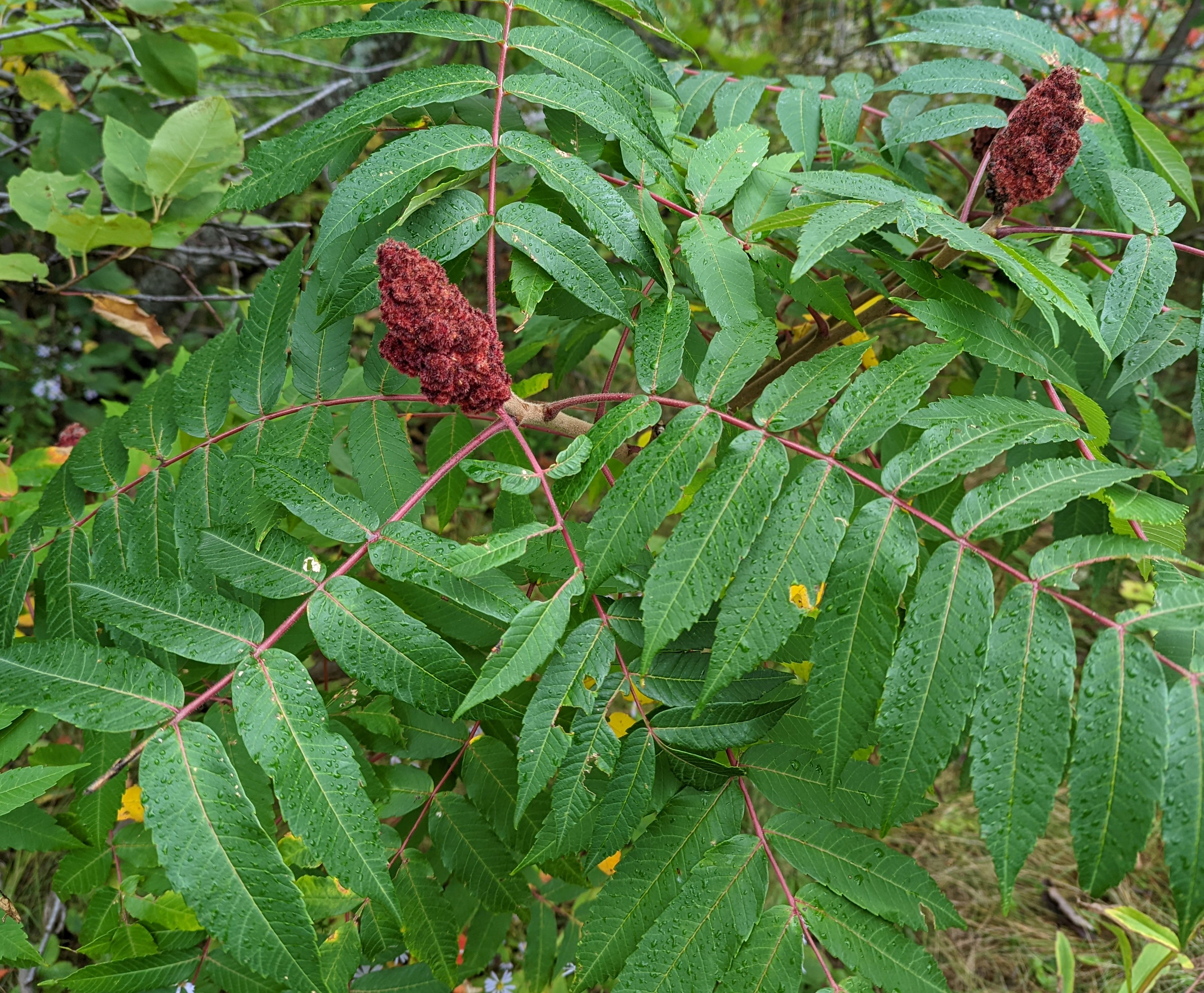
Like ToH, sumac has long, compound leaves with several leaflets. However, leaflets on sumac leaves have coarsely toothed or serrated edges. There are no small glandular lobes at the base of the leaflets such as those on ToH. Additionally, sumac leaflets are narrower than those of ToH and taper more gradually to the tip. Stems of sumac are often hairy, reddish-brown and quite distinct from the bark on ToH. Although flowers on sumac and ToH have a similar appearance, take a sniff. Sumac flowers have no scent, while ToH flowers are notably foul-smelling.
Is ToH sometimes used to help manage SLF?
Because ToH is such an important resource for SLF, pest managers and regulatory officials may use individual trees to help detect, monitor, or control SLF populations (Figure 28).
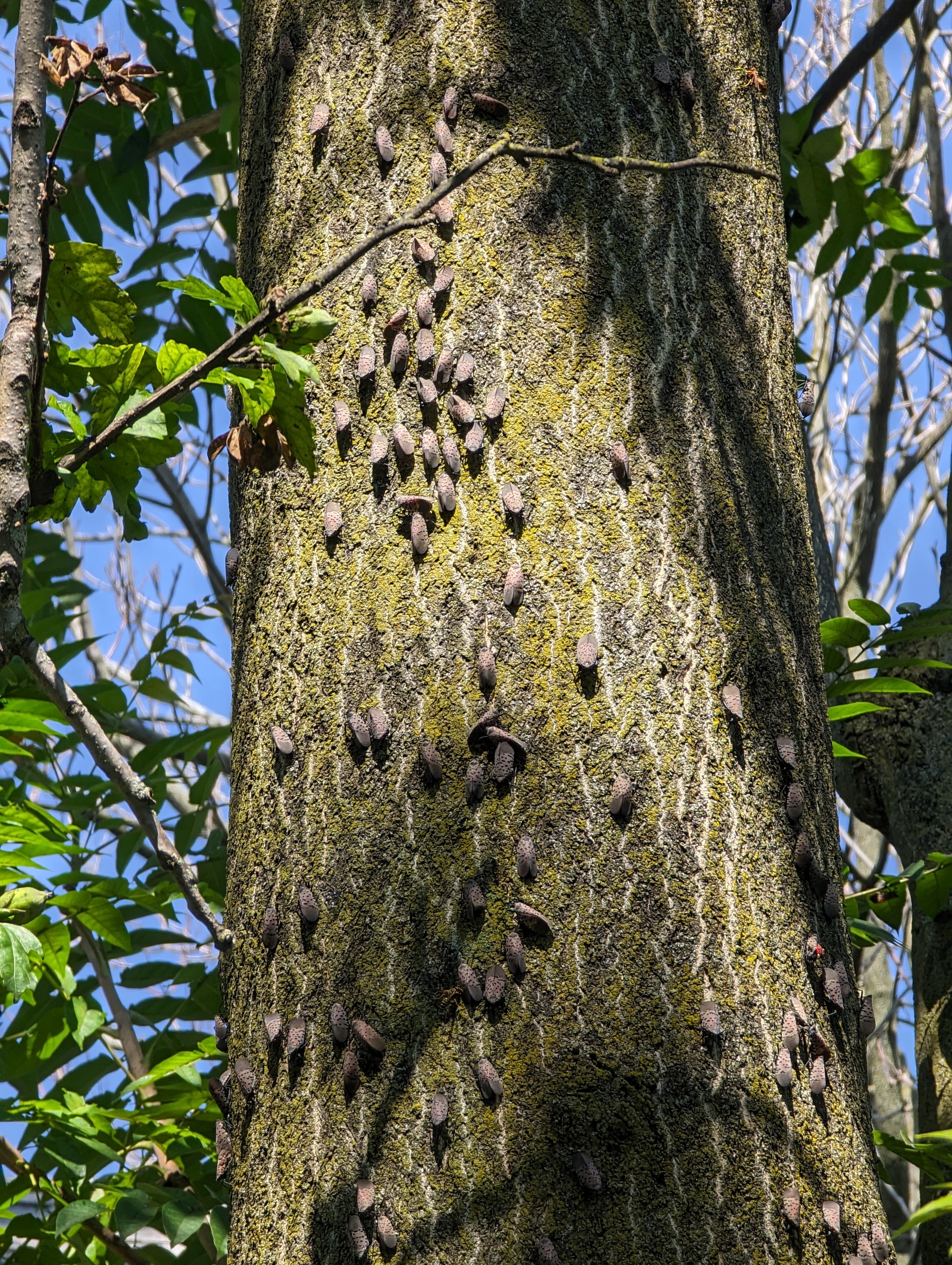
Traps to capture SLF nymphs and adults are sometimes placed on the trunks of ToH to detect new infestations or to monitor SLF development and activity. Scientists are evaluating various trap designs to capture SLF as they move about on trees. “Lampshade” traps to attract egg-laying SLF females are also being tested.
One option for using ToH to control SLF includes scraping off egg masses (Figure 29) laid on ToH trees. Egg masses are present from fall through winter to early spring and can be scraped off whenever they are encountered (Figure 30). Soak egg masses in soapy water for a few days to ensure the eggs are killed.
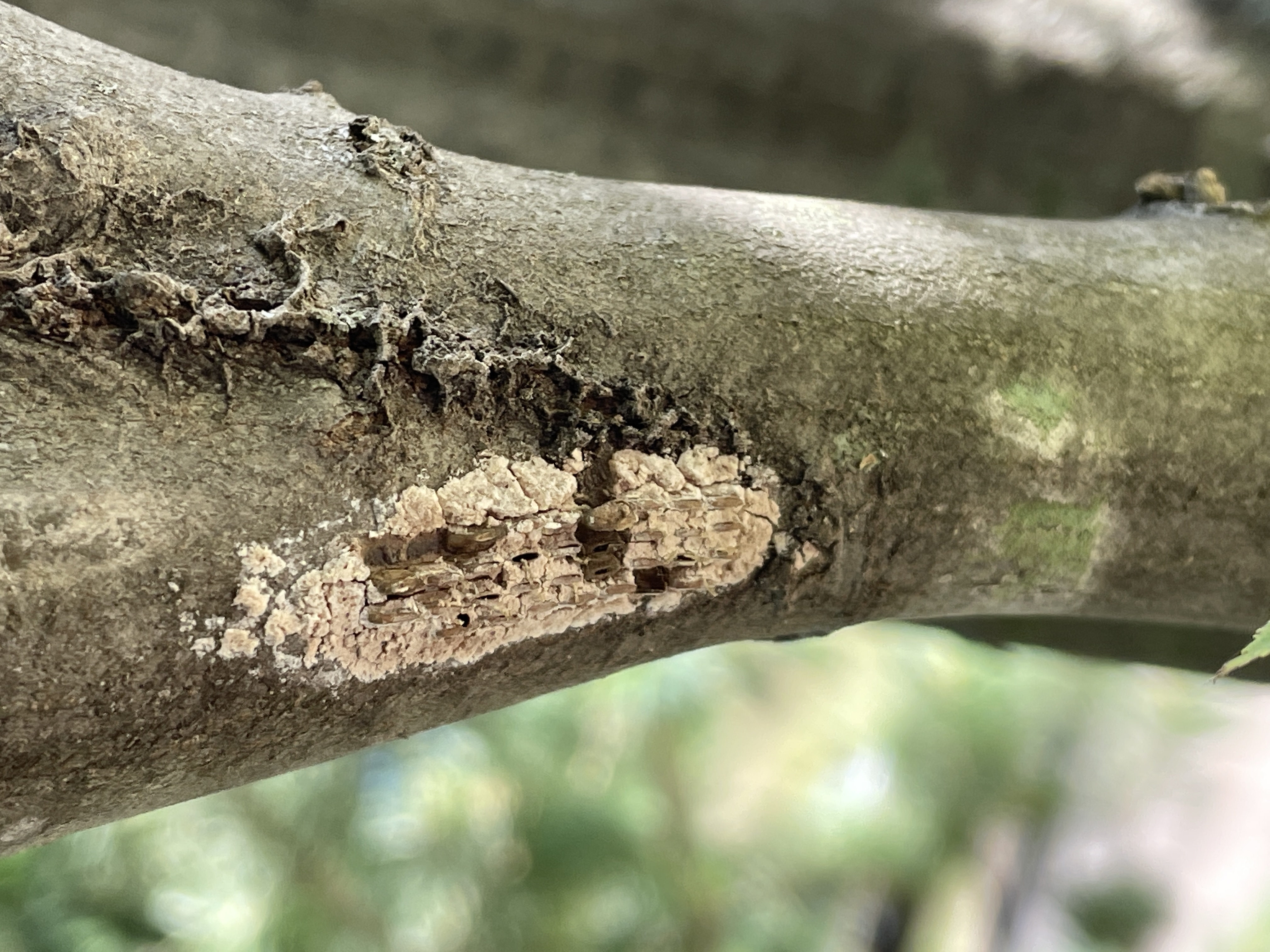
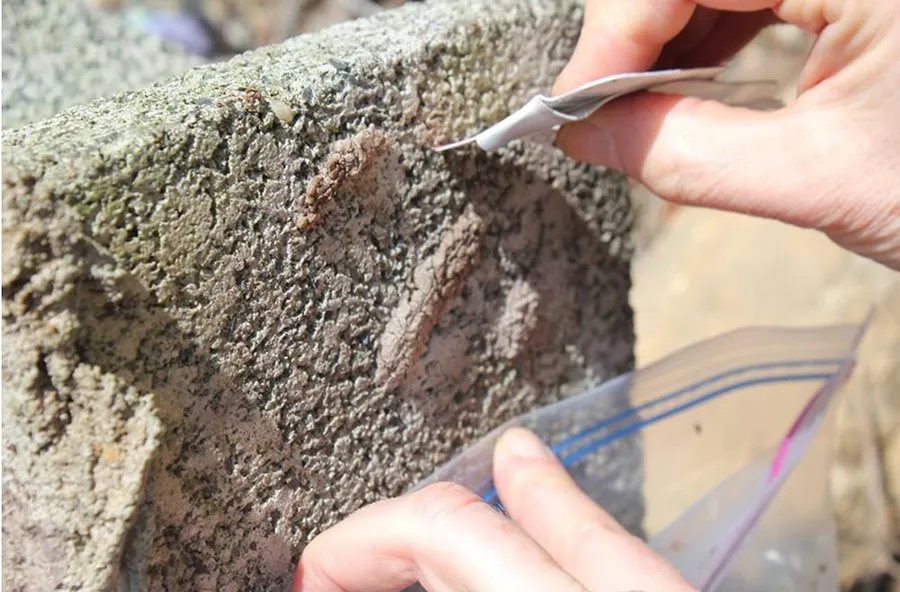
In areas where SLF is established, lethal trap trees can be created to reduce the density of a local SLF population. Remove or kill female ToH trees (see the following section on removing ToH from your property), leaving only a few male trees. Apply a systemic insecticide such as dinotefuran and imidacloprid to the remaining male ToH stem in mid- or late summer (after flowering is completed). Systemic products can be applied (1) as a basal bark spray to the lower 4 to 5 feet of the trunk, (2) by pouring formulated product onto soil right around the base of the tree for uptake by roots, or (3) by using specialized equipment to inject the insecticide into the base of the trunk. Systemic insecticides are transported up the trunk and into canopy branches, leaves, and flowers. SLFs that feed on a treated tree will die. Note that systemic insecticides should not be applied to trees that are flowering to avoid harming pollinators that may visit flowers.
In some situations, ToH trees that have been treated with a systemic insecticide are used for SLF detection or monitoring. A small plastic wading pool or similar basin is placed around the base of treated trees to catch dead SLF insects falling from the treated tree. Basins can be checked periodically by regulatory officials or scientists to evaluate SLF presence and life stages.
How can I remove ToH on my property?
Before you begin ToH removal or control, take the time to be absolutely certain the tree(s) in question is ToH and not sumac, black walnut, or another desirable species. Also be aware that removing ToH can be challenging and may require multiple years.
If you plan to physically or mechanically remove ToH, consider wearing protective clothing such as long sleeves, pants, gloves, and eye protection. Leaves, sap, and even sawdust from ToH may cause skin irritation in sensitive individuals. Avoid exposure to ToH sap if you have an open wound.
Seedlings (Figure 31) of ToH have leaves with three leaflets or lobes on slender stalks. New seedlings that have recently germinated from seeds can sometimes be pulled out of the soil. Be sure to remove all the roots along with the aboveground portion of the seedlings. Any root fragments left in the soil can produce new sprouts.
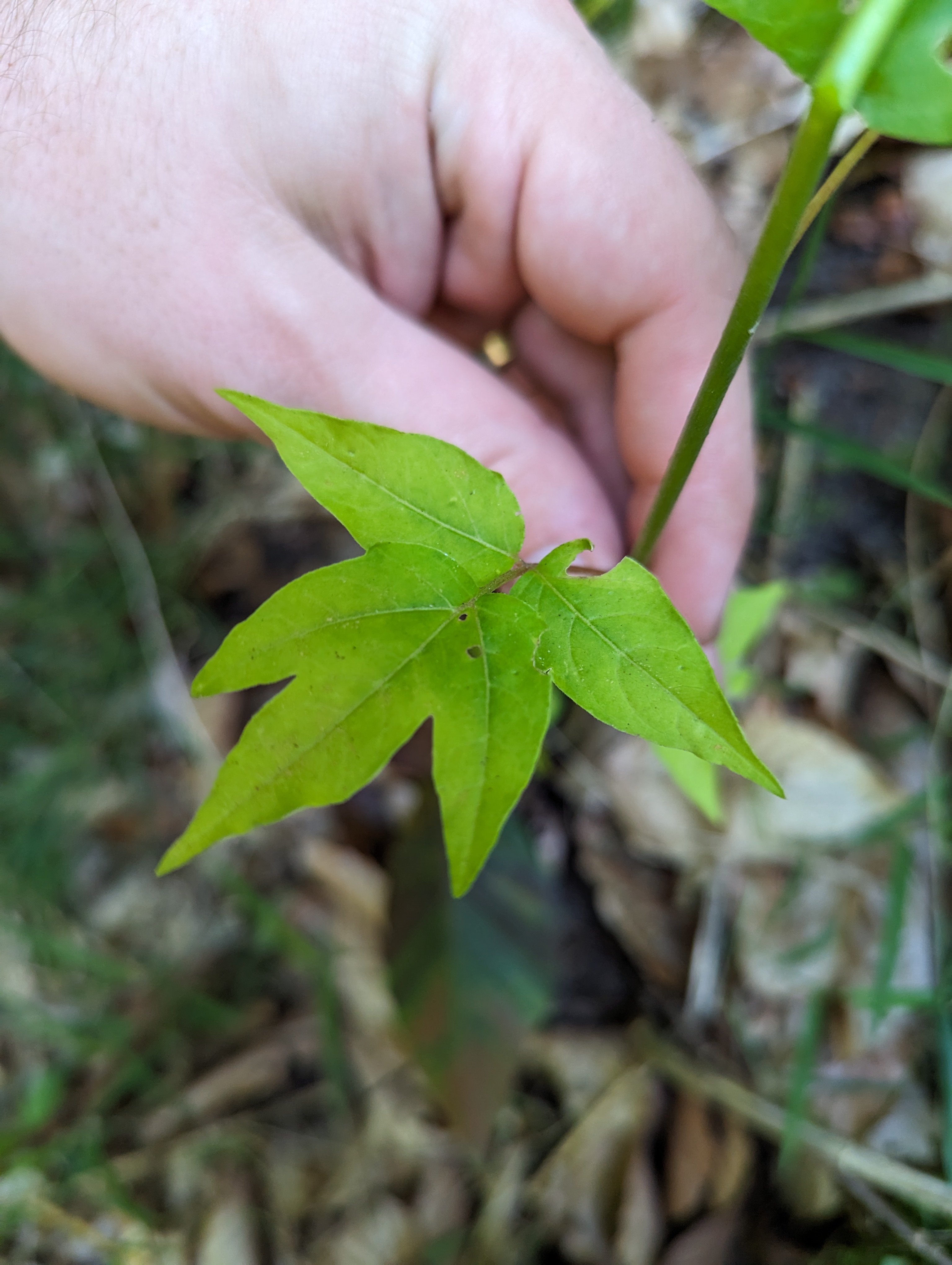
Roots sprouts (Figure 32) are easily confused with seedlings but are more robust and will be difficult to pull out of the soil because of their established root system. If the stem simply breaks off, the plant is likely a root sprout and additional action, such as the options described in the following sections, will probably be needed to prevent more sprouts emerging.
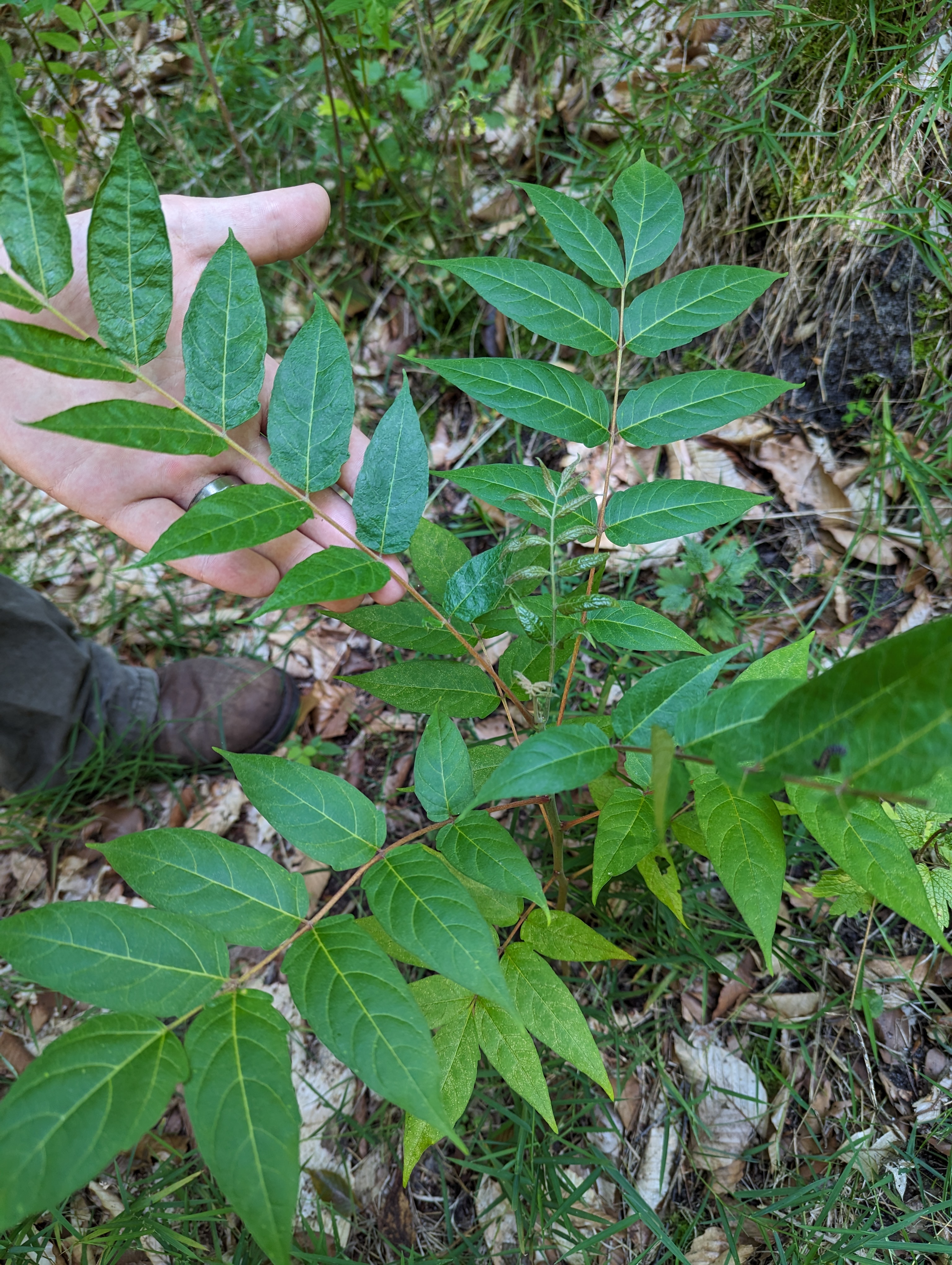
When clumps of young ToH sprouts or saplings are present (Figure 33), mowing, brush hogging, or chopping the stems may be a practical option. Sprouts and suckers will require repeated mowing, probably over multiple years, before root reserves are depleted. If sprouting persists, you may need to apply herbicide.
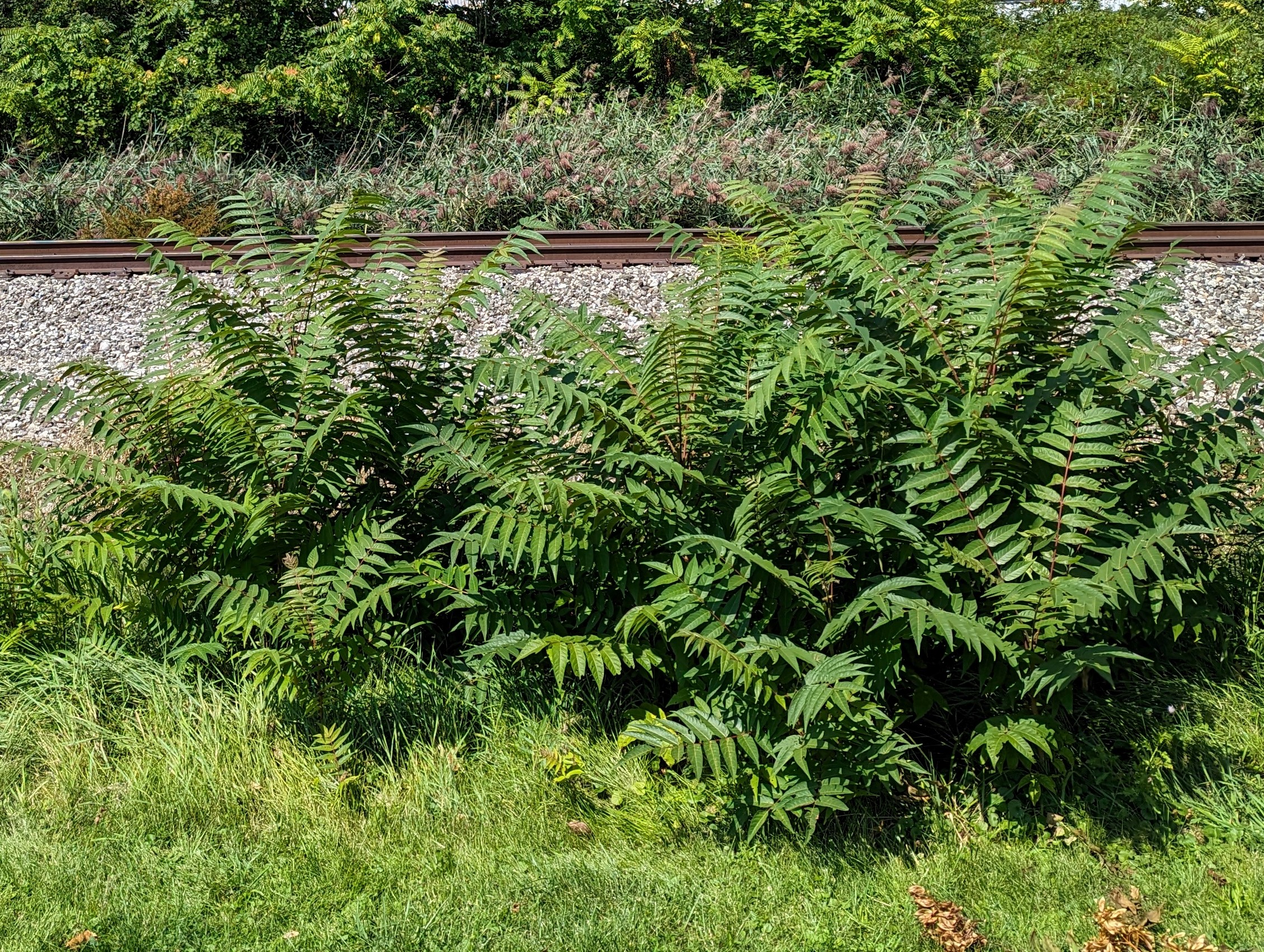
Digging up stems and roots of ToH saplings is labor intensive and rarely practical unless there are no other options. Ensuring all roots and other vegetative material are removed is challenging.
Felling larger ToH can be a good option if trees can be safely dropped without damaging structures, utility lines, or vehicles (Figure 34). Cutting large ToH will prevent new seeds from forming and obviously prevents SLF feeding. Felling ToH is best done in spring, just after leaf-out when nutrient reserves in roots are lowest. Wood from felled ToH trees can be used for firewood, woodworking material, or other uses.
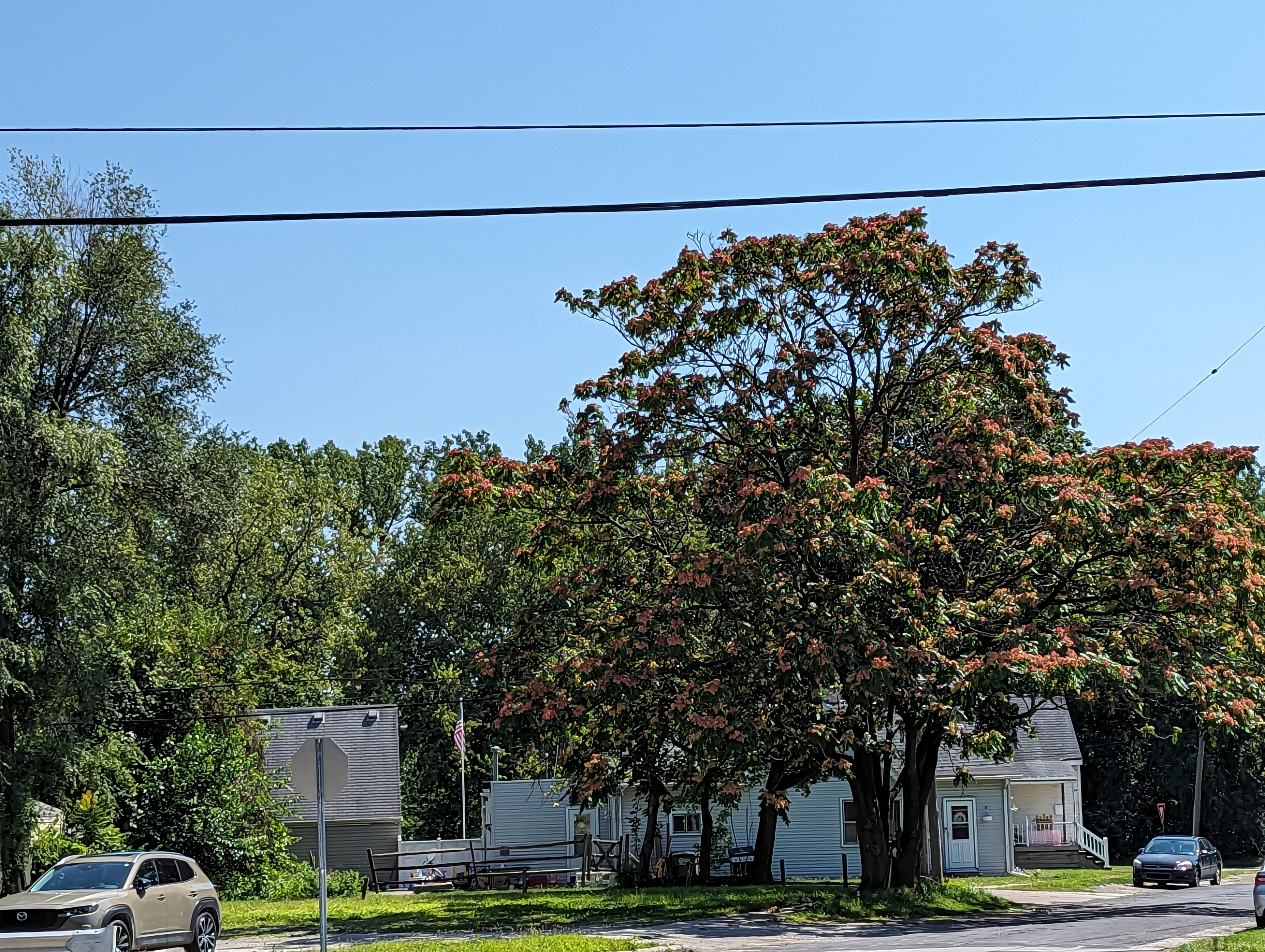
Sprouts from stumps and roots of a felled tree, however, will likely require control. Apply herbicide to ToH approximately 4 to 5 weeks before you fell the tree or to a freshly cut stump. Doing so should reduce the number of stump sprouts or root sprouts emerging after the tree is dropped. Monitor stumps and watch for root sprouts for two growing seasons to be confident that roots are dead and additional sprouts won’t appear.
Girdling a tree involves cutting through the outer bark, then inner bark (phloem), and into the live sapwood (xylem) all the way around the circumference of the trunk to impede the flow of nutrients and water inside the tree. Typically, an 8- to 12-inch-wide band of outer bark and inner bark around the trunk is removed. Girdling will eventually kill a ToH tree but also stimulates sprouting. Herbicide applied to the girdled area can help to limit sprouts and suckers. Girdling can be an efficient option to eliminate large, seed-producing trees. Note that if standing dead ToH trees pose a hazard, they may still need to be felled (Figure 35).
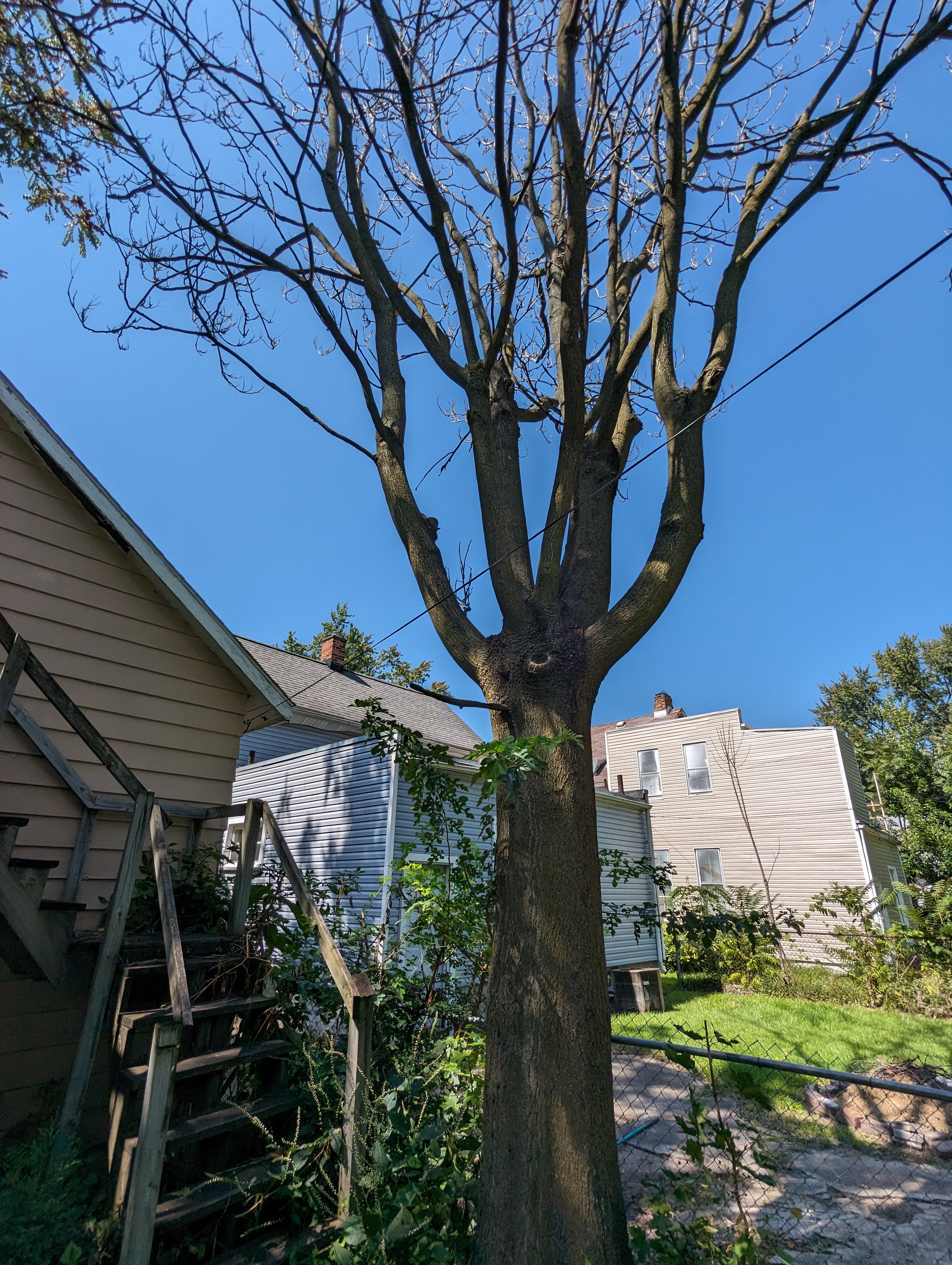
Herbicide application is often the preferred and most efficient option for controlling ToH. Effective herbicides can kill standing trees and roots, reducing problems with sprouts. Apply herbicides between mid-July and early fall, when leaf color begins to change. Treatment at other times of the year kills trees more slowly and may be less effective.
Numerous products are available for ToH control. Selecting a herbicide will depend on several factors including the size and number of trees that require treatment, along with the surrounding desirable vegetation and landscape features.
Various herbicide products may be applied by spraying the lower portion of the trunk or injecting stems or trunks of trees. When trees are small enough, some herbicides can be applied by spraying the product onto leaves (Figure 36). You can also treat cut stumps with herbicide to prevent stump sprouting from trees that have been felled.
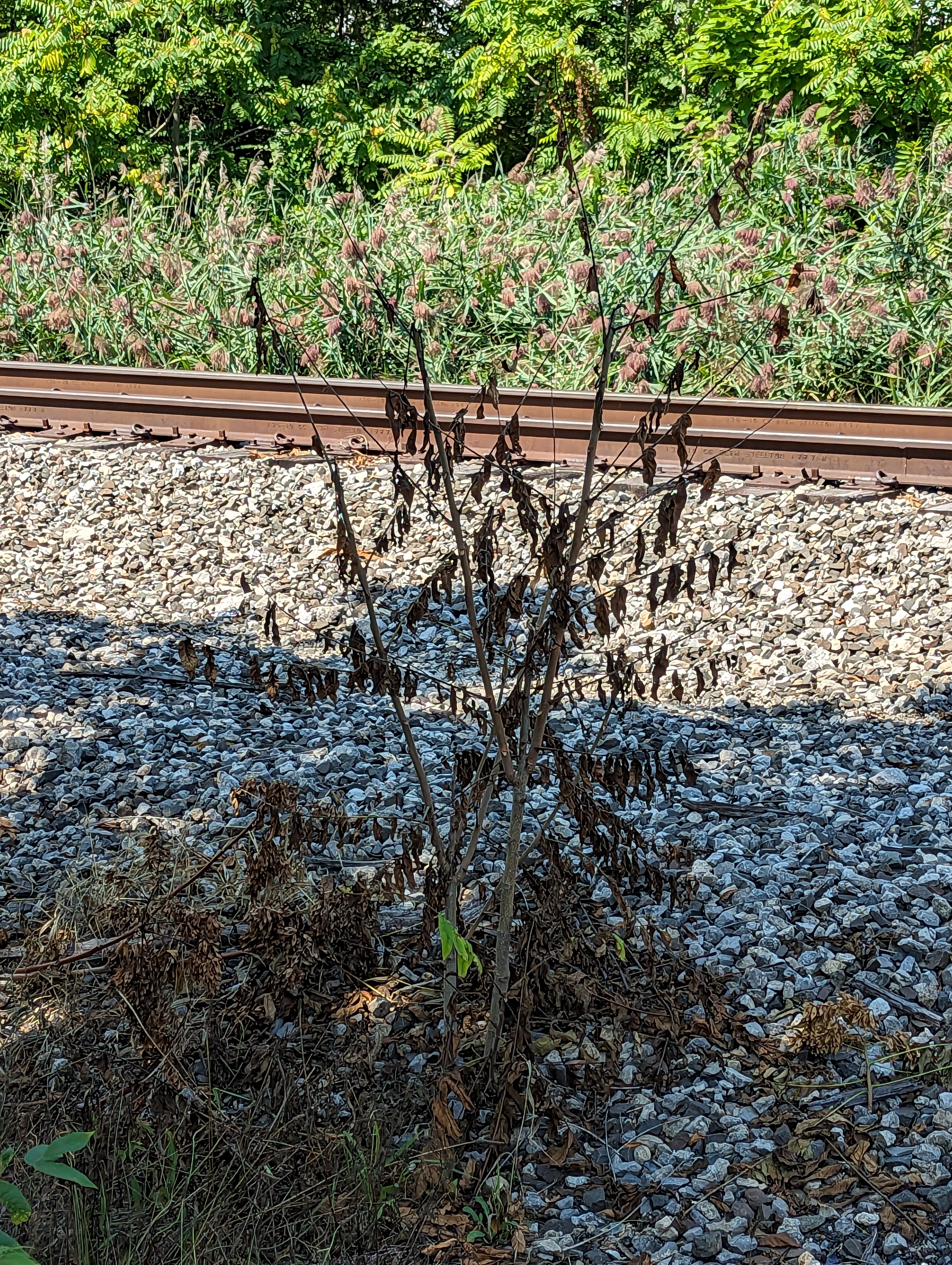
If you are using herbicides to control ToH, be aware of surrounding vegetation. Use appropriate measures to avoid harm to other trees or plants that are desirable. Always read and follow directions on the label to ensure maximum personal and environmental safety; the label is the law. Possible environmental hazards, including areas where the product should not be used, are included on the label.
Foliar sprays (Figure 37) can be considered when there are dense clusters or clumps of young ToH less than 10 feet tall. Herbicides containing the active ingredients glyphosate or triclopyr amine (water based) may be used separately, but generally work better if applied as a tank mix. To increase foliar retention, a surfactant may be needed unless the product label indicates a surfactant is included. Glyphosate is nonselective and will kill or injure other plants contacted by the spray. Triclopyr poses the most significant hazard to other broadleaf plants (i.e., dicots), but generally does not negatively affect grasses when used as directed. Be careful with sprays to avoid harming nontarget vegetation.
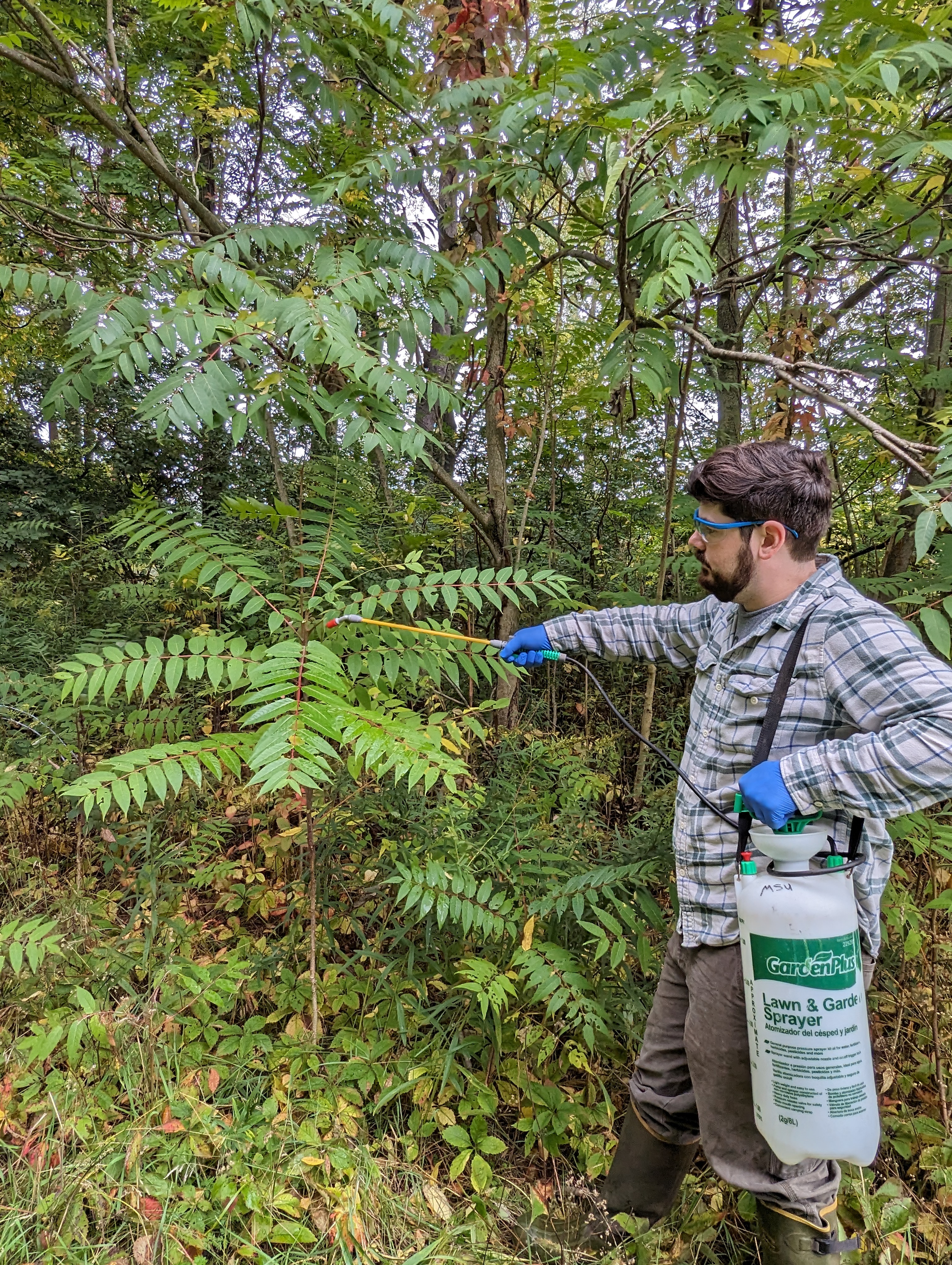
A basal bark spray refers to spraying herbicide on the lower portion of the stem (Figure 38). This application method can be effective if stems (tree trunks) are less than 6 inches in diameter. Apply herbicide to the bark on the lower 12 to 18 inches of the stem and be sure to spray the entire circumference of the stem. Basal bark sprays can be used as an alternative to foliar herbicide application when trees are tall or when desired vegetation is present near or beneath the ToH. Triclopyr ester (oil based) products are generally used for basal bark sprays. Note that some products can be purchased and applied only by certified pesticide applicators.
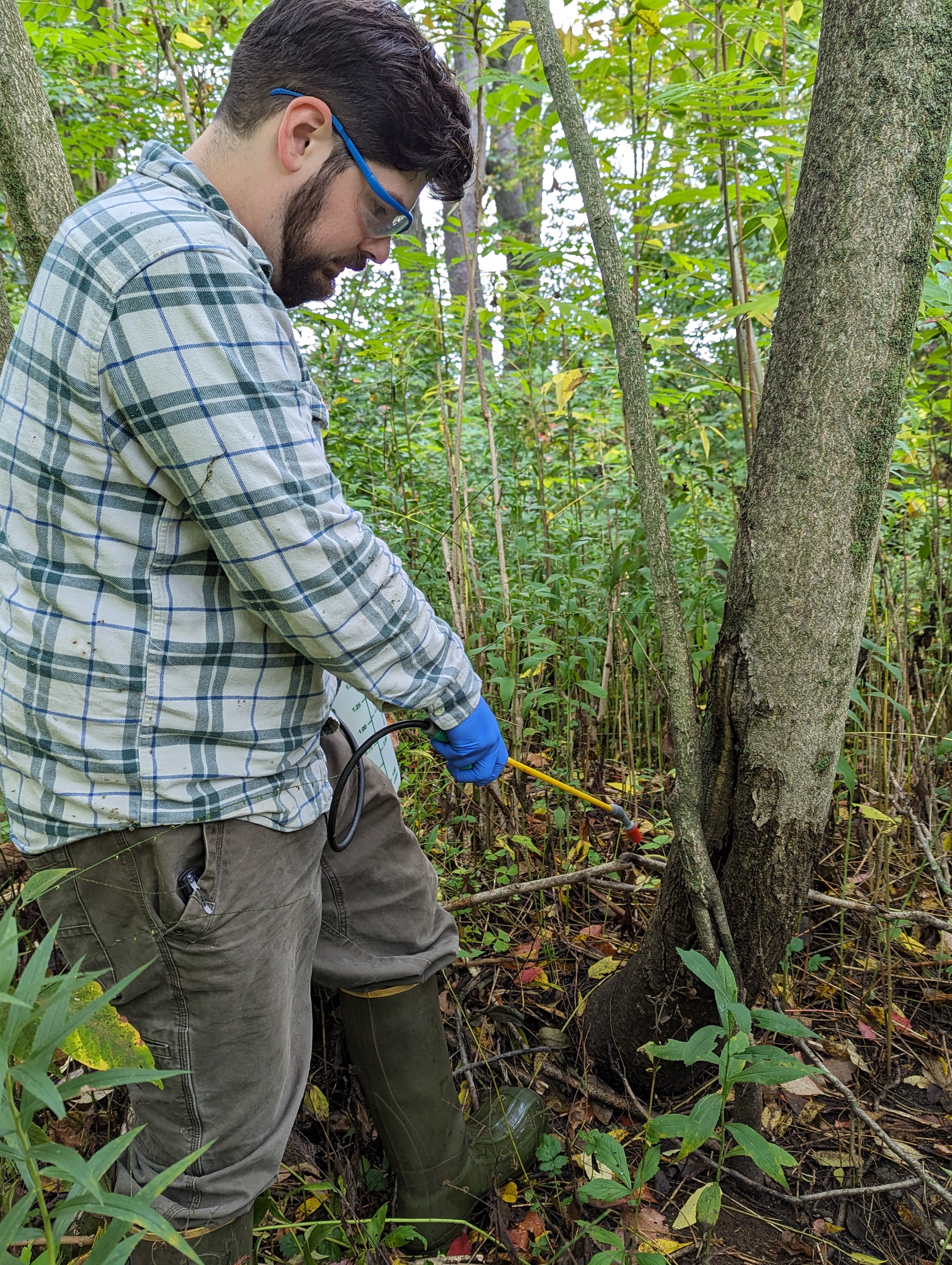
Stem injection, commonly called hack-and-squirt or frilling, is most often used to apply herbicide to trees larger than 6 inches in diameter, although it can be used on stems as small as 1 inch in diameter. This method entails using a hatchet to make downward cuts into the bark of the tree at regular intervals around the circumference of the trunk. Apply herbicide (glyphosate or triclopyr amine) into the cuts (frills) using a squirt bottle, garden sprayer, or backpack sprayer. Follow label directions of the product to ensure proper spacing of cuts and application rates.
To make the cuts, strike the stem at a 45-degree angle, 2 to 3 feet above the ground. Avoid girdling the stem and leave the outer bark between the cuts intact. Immediately (within 1 to 2 minutes) apply the herbicide into each cut. Fill each cut and avoid runoff down the stem.
A cut stump treatment involves thoroughly covering the top and sides of the cut stump with concentrated herbicide within minutes of felling the tree. Products with triclopyr esters are recommended but herbicides with imazapyr and 2, 4-D with picloram should also be effective. Monitor the treated stump for at least one year. Use additional herbicide to control new stump sprouts or root suckers as needed. Extra caution is needed when using imazapyr and picloram as they can have long lasting effects in the soil.
Secondary insects – ambrosia beetles: If a herbicide application does not completely kill the ToH, it will often make the tree susceptible to attack by tiny woodboring ambrosia beetles. Ambrosia beetles chew through the outer bark into the wood, leaving narrow ”toothpicks” of sawdust that protrude from the bark (Figure 39). Cutting into infested wood will expose beetle galleries stained with black fungus. Ambrosia beetles are attracted only to severely stressed trees, including ToH stressed by herbicide application. If herbicide does not kill the tree, ambrosia beetles will usually finish it off.
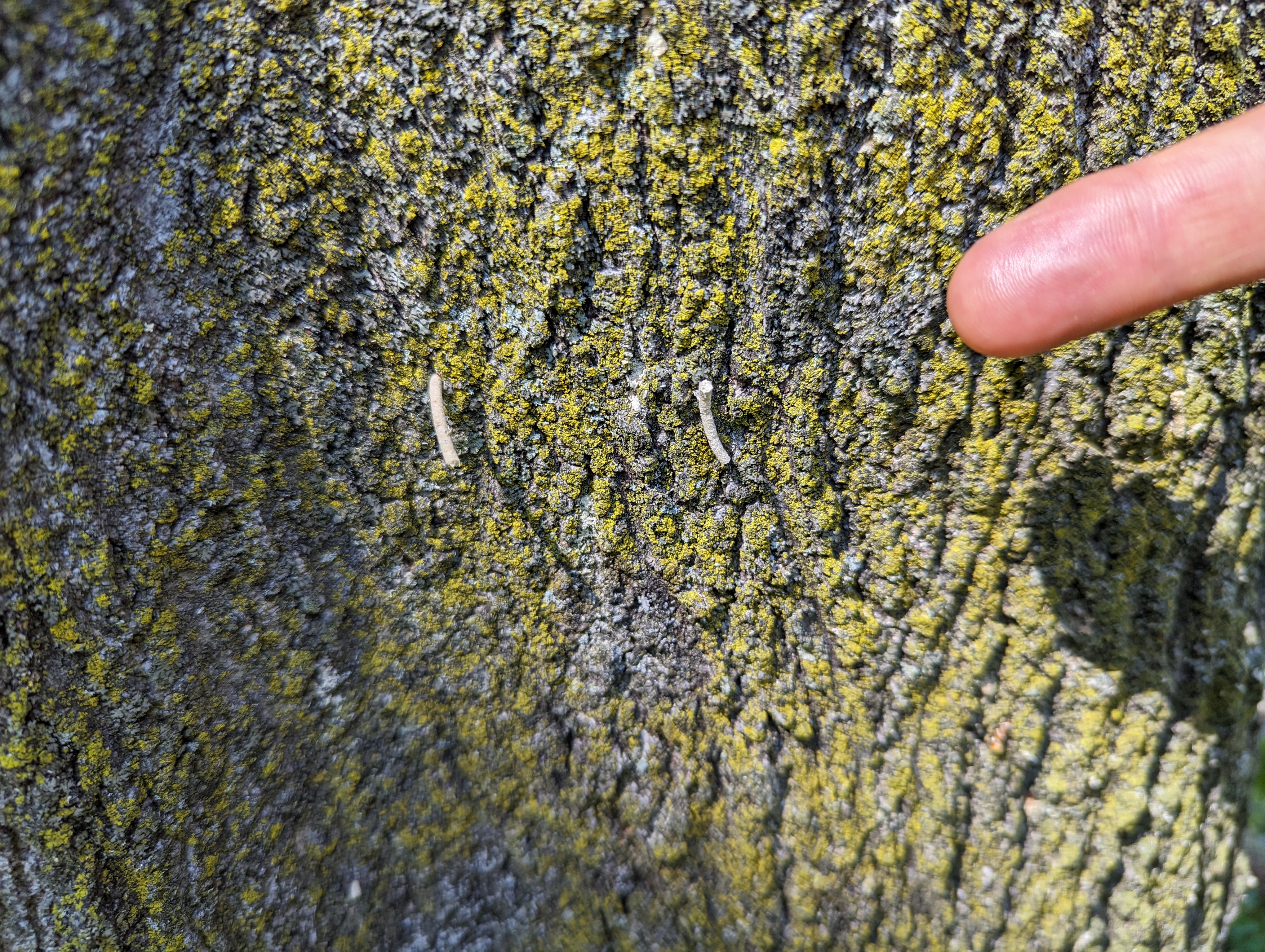
Once you have controlled ToH, plant or encourage the growth of more desirable trees and shrubs in the area. Over time, shade provided by the preferred species will slow or prevent ToH growth and spread.
Additional Resource
Virginia Department of Forestry. (2019). Control and utilization of tree-of-heaven: A guide for Virginia landowners. https://www.dof.virginia.gov/wp-content/uploads/Control-and-Utilization-of-Tree-of-Heaven_pub.pdf
Reference
Fryer, J. L. (2010). Ailanthus altissima. Fire Effects Information System. U.S. Department of Agriculture, Forest Service, Rocky Mountain Research Station, Fire Sciences Laboratory. https://www.fs.usda.gov/database/feis/plants/tree/ailalt/all.html#:~:text=Tree-of-heaven



 Print
Print Email
Email
